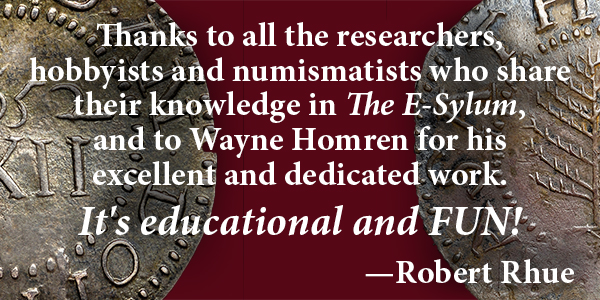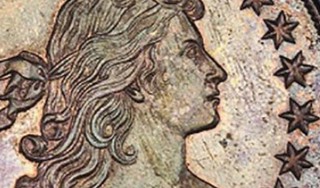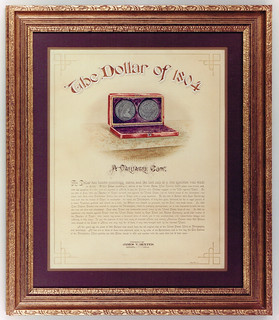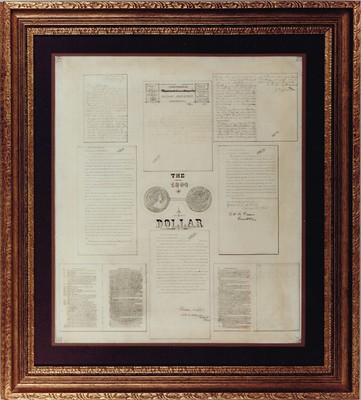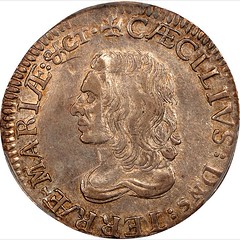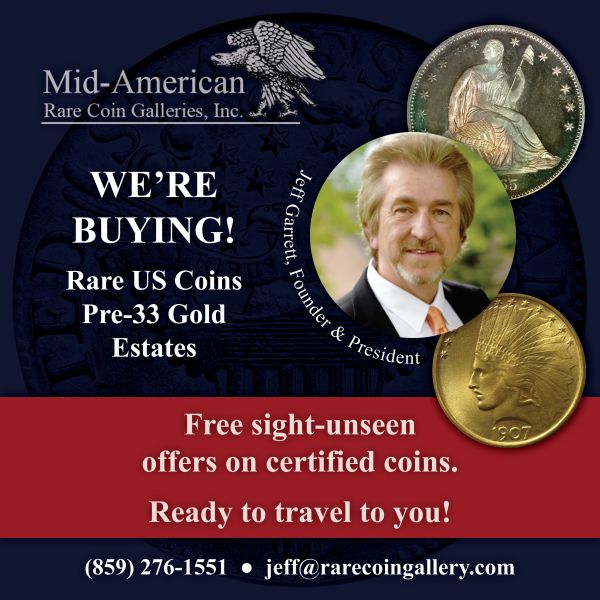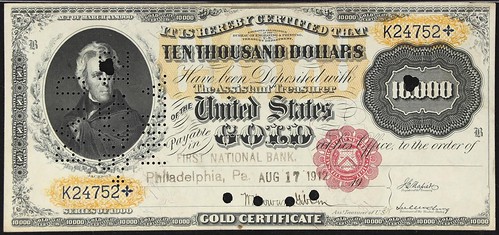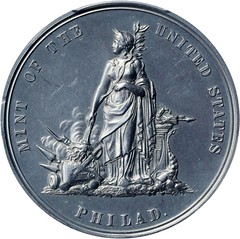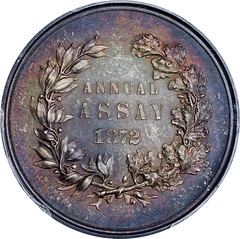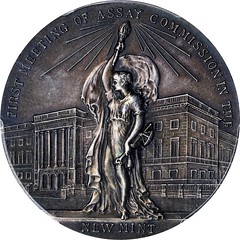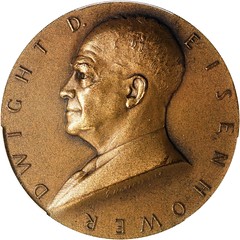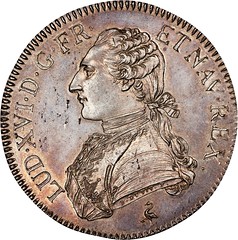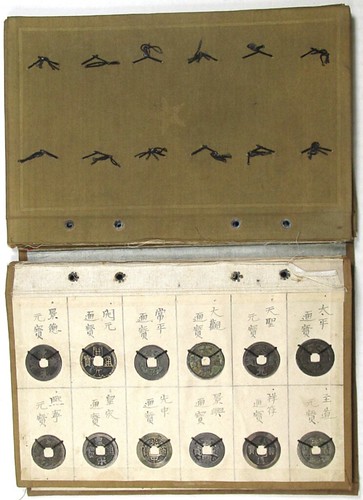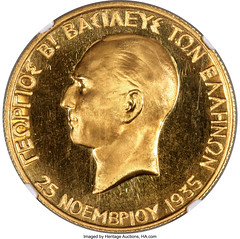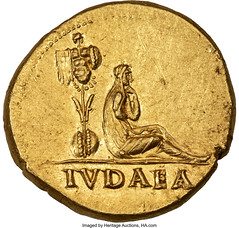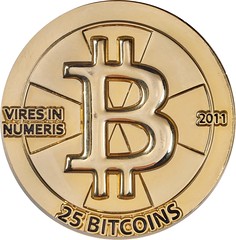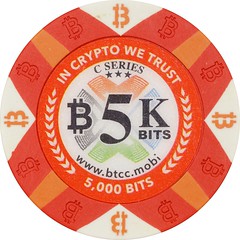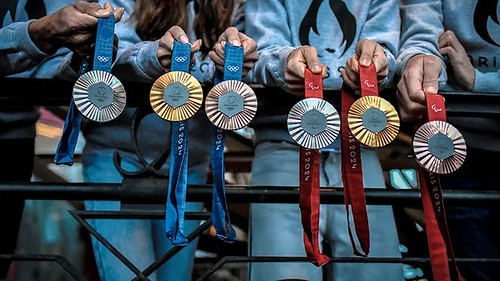
Visit our NBS Sponsors
About UsThe Numismatic Bibliomania Society is a non-profit association devoted to the study and enjoyment of numismatic literature. For more information please see our web site at coinbooks.org SubscriptionsThose wishing to become new E-Sylum subscribers (or wishing to Unsubscribe) can go to the following web page link MembershipThere is a membership application available on the web site Membership Application To join, print the application and return it with your check to the address printed on the application. Print/Digital membership is $40 to addresses in the U.S., and $60 elsewhere. A digital-only membership is available for $25. For those without web access, write to: Jeff Dickerson, Treasurer AsylumFor Asylum mailing address changes and other membership questions, contact Jeff at this email address: treasurer@coinbooks.org SubmissionsTo submit items for publication in The E-Sylum, write to the Editor at this address: whomren@gmail.com BUY THE BOOK BEFORE THE COINSale CalendarWatch here for updates! |
- WAYNE'S WORDS: THE E-SYLUM AUGUST 4, 2024
- NBS ACTIVITIES AT THE ANA CONVENTION
- NEW BOOK: MONEY & PROMISES
- NEW BOOK: MEDALS OF THE ROYAL CANADIAN MINT, 2ND ED.
- MINT MASTER COVERS EARLY BOWERS PUBLICATIONS
- VIDEO: SS CENTRAL AMERICA DISCOVERY
- NUMISMATIC WRITERS RECEIVE ANA AWARDS
- 2024 ANA CONVENTION EXHIBIT GUIDE
- 1804 DOLLAR NUMISMATIC LITERATURE
- NOTES FROM E-SYLUM READERS: AUGUST 4, 2024
- VOCABULARY TERM: PREMIUM
- ANA DOCTOR OF NUMISMATICS ROSTER
- STAN KESSELMAN INTERVIEW, PART SEVEN
- ERIC SCHENA INTERVIEW, PART FOUR
- NUMISMAGRAM MEDAL SELECTIONS: AUGUST 4, 2024
- SYD MARTIN COLLECTION PART IV HIGHLIGHTS
- SBG OFFERS BANCO DE MEXICO NOTES
- 1900 $10,000 GOLD CERTIFICATE OFFERED
- KEUSCH COLLECTION OF ASSAY MEDALS
- RICHARD MARGOLIS COLLECTION, PART II
- ARCHIVES INTERNATIONAL SALE #96 SELECTIONS
- HERITAGE ANA WORLD & ANCIENT SELECTIONS
- STACKS BOWERS PHYSICAL BITCOIN AUCTION
- PERSIAN GOLD COINS FOUND IN TURKEY
- 2024 PARIS OLYMPIC MEDALS
- LOOSE CHANGE: AUGUST 4, 2024
Content presented in The E-Sylum is not necessarily researched or independently fact-checked, and views expressed do not necessarily represent those of the Numismatic Bibliomania Society.
WAYNE'S WORDS: THE E-SYLUM AUGUST 4, 2024
 We've been experimenting with a new email provider - MailChimp. We're ready to recruit some testers. If you'd like to try out this alternate version, please go to this page and enter your name and email
address:
http://eepurl.com/iAHJaA
For the initial weeks I'll send out a copy of the issue myself one evening during the week. If all goes well we'll start sending it on Sunday nights alongside our current version.
We've been experimenting with a new email provider - MailChimp. We're ready to recruit some testers. If you'd like to try out this alternate version, please go to this page and enter your name and email
address:
http://eepurl.com/iAHJaA
For the initial weeks I'll send out a copy of the issue myself one evening during the week. If all goes well we'll start sending it on Sunday nights alongside our current version.
This week we open with a final reminder of NBS activities at this week's ANA, two new books, updates from the Newman Numismatic Portal, notes from readers, and more.
Other topics this week include early Q. David Bowers publications, ANA convention exhibits, the 1804 Dollar, the ANA Honorary Doctor of Numismatics, fixed price and auction previews - a TON of those (great numismatic eye candy), a Persian gold hoard find, and the 2024 Olympic medals.
To learn more about the fine arts of bookbinding, California Pioneer Fractional Gold, the SS Central America discovery, Wildman Thalers, three cent patterns, Postage and Fractional Currency, the Norfed American Liberty Dollars, the Marquette Building panels by Hermon MacNeil, Premium Medals, panic money, the 1773 Virginia "Penny," Assay medals, and the history of the American bookstore, read on. Have a great week, everyone!
Wayne Homren
Editor, The E-Sylum
NBS ACTIVITIES AT THE ANA CONVENTION
As a final reminder, here are excerpts of Numismatic Bibliomania Society President Len Augsburger's earlier notes on planned club activities at this week's American Numismatic Association World's Fair of Money®. I'll look forward to seeing many of you there! -Editor
 NBS Activities at the ANA Convention
NBS Activities at the ANA Convention
Once again, the ANA Convention will feature a full slate of NBS activities. Our club table on the bourse floor is 1321, conveniently located adjacent to book dealers Kolbe & Fanning and Charles Davis. Tom Harrison will be hosting the club table on Tuesday, with Jeff Dickerson taking over on Wednesday. Jeff has been learning the fine arts of bookbinding and will be doing a demo of box building for attendees. Boxes will be suitably sized to contain back issues of the The Asylum. This is your chance to create a one-of-a-kind commemorative of NBS history!
Numismatic Bibliomania Society 2024 Charity Auction
 The NBS 2024 Charity Auction sale catalog is now available. Compiled by David Fanning with layout by Maria Fanning, the catalog includes 50 lots donated by NBS members. The sale will take place Friday, August 9, 11:30AM at the ANA convention (room 12). Mail bids may be submitted to David Fanning through August 8.
The NBS 2024 Charity Auction sale catalog is now available. Compiled by David Fanning with layout by Maria Fanning, the catalog includes 50 lots donated by NBS members. The sale will take place Friday, August 9, 11:30AM at the ANA convention (room 12). Mail bids may be submitted to David Fanning through August 8.
Link to NBS 2024 Charity Auction sale catalog:
https://coinbooks.org/nbsauction2024.pdf

Also, the NBS Symposium will feature Robert D. Leonard speaking on the upcoming third edition of California Pioneer Fractional Gold, while Len Augsburger will discuss the forthcoming bibliography of Eric P. Newman, to be published by Kolbe & Fanning. -Editor
Donald E. Stephens Convention Center
5555 N River Rd, Rosemont, Illinois
Thursday, August 8 at 1:00PM (Room 10)
Friday, August 9 at 11:30AM (Room 12)
To read the earlier E-Sylum articles, see:
NBS ACTIVITIES AT THE ANA CONVENTION
(https://www.coinbooks.org/v27/esylum_v27n29a02.html)
2024 NBS CHARITY AUCTION AND ANA EVENTS
(https://www.coinbooks.org/v27/esylum_v27n30a02.html)
NEW BOOK: MONEY & PROMISES
The Wall Street Journal reviewed a new book about the evolution of money, great background for numismatic collectors and researchers. Here's an excerpt - see the complete article online. -Editor
 For millennia, money was a physical object, from Chinese cowrie shells to Roman coins. It ably served its societies, but only to a point. Over time, a new possibility emerged: the concept that the promise to pay a debt can become money itself, something to be recorded, traded, credited and debited across an infinite number of parties.
For millennia, money was a physical object, from Chinese cowrie shells to Roman coins. It ably served its societies, but only to a point. Over time, a new possibility emerged: the concept that the promise to pay a debt can become money itself, something to be recorded, traded, credited and debited across an infinite number of parties.
Paolo Zannoni's "Money & Promises" is an ode to this transformation. He advances no grand theory or polemical critique but rather takes us on a flaneur's amble through history, digging through archives to present richly illustrated vignettes from Renaissance Italy to revolutionary-era Russia. He is most interested in the roles of banks and governments: The endless exchange of debts between them, he says, has presented great opportunities, though they are "fraught with dangers."
The action picks up in Pisa, Italy, in the late 14th century, where the port city was thriving but strained by the limited supply of gold florins to meet the needs of its artisans and traders. Eagerly prowling Italian archives, Mr. Zannoni reviews the dealings of a small bank whose records have survived to the present. They show how "bank money"—his term for the transformation of debt to money—was replacing coinage as a means of trade. In one case, a wool merchant who was owed 36 florins used that debt, in turn, to pay off 36 florins of his own debts, with the bank keeping detailed ledgers to ensure that the offsets were accurate and fair. A trivial matter? Mr. Zannoni views it as revolutionary.
One key to such a system was trust in the institutions that traded in debt. Mr. Zannoni recounts the nuances of finance in Venice, where banks were swamped by foreign merchants of dubious creditworthiness and routinely found themselves with too little hard currency to back their own balance sheets. In 1496, Mr. Zannoni says, Venice was home to about 10 banks. Within 50 years, they had all gone bust. The wise men of Venice reacted as their 21st-century counterparts did: They regulated the banks, enforcing more hard-currency requirements and less speculative forms of "bank money."
The state moves more fully into the picture with the creation of the Bank of England in 1694. Back then, Mr. Zannoni tells us, England's banks used tally sticks to keep track of debts, typically for taxes owed to the government. These sticks—literally willow-tree limbs notched in patterns to record financial information—were a kind of ersatz database.
To read the complete article (subscription required), see:
‘Money & Promises' Review: How to Spend What Is Owed
(https://www.wsj.com/arts-culture/books/money-promises-review-how-to-spend-what-is-owed-e98d3e0d)
NEW BOOK: MEDALS OF THE ROYAL CANADIAN MINT, 2ND ED.
Last year, Alan Roy published the first edition of his passion project, a book on Royal Canadian Mint medals and exonumia. A new edition is now available for sale. -Editor
 The second edition of The Medals & Exonumia of the Royal Canadian Mint is a 152-page, coil-bound listing of medals issued by Canada's national mint during its more than one hundred years of operation. It covers all known medals distributed by the mint. These include pieces sold directly to the public, issued in conjunction with events sponsored by the mint, and distributed by them at meetings and trade shows.
The second edition of The Medals & Exonumia of the Royal Canadian Mint is a 152-page, coil-bound listing of medals issued by Canada's national mint during its more than one hundred years of operation. It covers all known medals distributed by the mint. These include pieces sold directly to the public, issued in conjunction with events sponsored by the mint, and distributed by them at meetings and trade shows.
It also includes medals issued as tokens of appreciation to mint employees. Another section of the catalogue lists medals featuring the Royal Canadian Mint as a theme. Each piece is illustrated, and any known technical information is also provided. An estimate of value is also included for each piece.
The new edition includes several newly-discovered pieces and improved photographs. It also has a new, visual table of contents to make locating medals easier.
The Issue price is $25. Shipping is extra, $15 within Canada. Contact me at alroy477@gmail.com if you are interested. NOTE: prices are in Canadian dollars.
Sounds great - congratulations! -Editor
To read the earlier E-Sylum article, see:
NEW BOOK: MEDALS OF THE ROYAL CANADIAN MINT
(https://www.coinbooks.org/v25/esylum_v25n26a02.html)
MINT MASTER COVERS EARLY BOWERS PUBLICATIONS
The latest addition to the Newman Numismatic Portal is the newest issue of the Utah Numismatic Society's Mint Master. Project Coordinator Len Augsburger provided the following report. -Editor
The Mint Master Covers Early Bowers Publications
Published monthly by the Utah Numismatic Society, the Mint Master is compiled by Doug Nyholm, who notes he has now edited 180 consecutive issues. The August edition features a retrospective of three early house organs issued by Q. David Bowers. Nyholm writes "As I personally began collecting in 1962 at the age of 10 these publications to me are a time machine into what coin collecting was in my youth." Nyholm was ideally situated, as he recalls "my parents owned a country store and I was allowed to search the cash register till every night to look for those elusive circulation finds which were still made of silver."
Bowers, at the time a college student, was already operating at a professional level. The inaugural issue of Empire Topics features first-rate inventory (an entire roll of 1916-D dimes, an 1838 half dollar pattern, etc.), while Bowers' inquisitive mind could not help including features such as "New Massachusetts Cent Die Variety Discovered." An offering of Hard Times Tokens is accompanied by historical commentary, along with copies of the Lyman Low reference, exemplifying the Bowers approach, which Charles Davis aptly described as "an appealing mix of salesmanship and scholarship."
Image: Empire Topics for summer 1958, announcing the acquisition of an 1894-S Barber dime
Link to the Mint Master on Newman Portal:
https://nnp.wustl.edu/library/publisherdetail/533919
Link to Empire Topics:
https://nnp.wustl.edu/library/publisherdetail/535704
Link to Bowers Review:
https://nnp.wustl.edu/library/publisherdetail/535706
Link to the Empire Review:
https://nnp.wustl.edu/library/publisherdetail/535755
VIDEO: SS CENTRAL AMERICA DISCOVERY
The David Lisot Video Library on the Newman Numismatic Portal can be found at:
https://nnp.wustl.edu/library/multimediadetail/522852
We highlight one of his videos each week in The E-Sylum. Here's one from 2005 with Bob Evans and Dave Bowers speaking about the SS Central America Discovery. Wow! -Editor
On September 12, 1857, the SS Central America sank carrying the greatest lost treasure: tons of California gold. A team of scientists and engineers that included Bob Evans recovered over two tons of gold. This gold created a sensation in the numismatic community. Includes commentary by Q. David Bowers about the coins and people involved.
Speaker(s): Robert Evans.
It doesn't get much better than this - hearing first-hand from people who were directly involved in numismatic history. Be sure to watch! -Editor
To watch the complete video, see:
SS Central America Discovery
(https://youtu.be/KuDmaFk0lUw)
NUMISMATIC WRITERS RECEIVE ANA AWARDS
Congratulations to the winners of ANA's 2024 literary awards! Here's the announcement. Publishing articles in a peer-reviewed national journal isn't for dabblers. Lots of great topics and research this year. Lots of familiar names here - many of these authors participate in E-Sylum exchanges as well. -Editor
The American Numismatic Association's 2024 literary awards – recognizing articles published in the 2023 volume of its official magazine, The Numismatist – will be presented during the Member Awards and Donor Celebration at the Chicago World's Fair of Money® on Aug. 8. The Numismatist was launched by ANA founder and first editor Dr. George F. Heath in 1888. This year marks its 137th volume.
 The Heath Literary Award, introduced in 1949, acknowledges outstanding articles published in the preceding 12 months.
The Heath Literary Award, introduced in 1949, acknowledges outstanding articles published in the preceding 12 months.
- First place goes to William R. Eckberg for "French Liberty & the American Civil War" (September 2023).The author will receive $250, an engraved nickel-silver medal, and a certificate.
- David Schenkman earned second place ($100, an engraved bronze medal, and a certificate) for "Philadelphia Incuse Lettering Tokens of the 1850s" (October 2023).
- In third place (engraved bronze medal and a certificate) is Ronald B. Gammill and John F. Conour for "Overlooked & Misattributed: The Medallions, Medalets, and Counterstamps of Lafayette's 1824 Visit" (June 2023).
 The Wayte and Olga Raymond Memorial Literary Award, endowed in 1978 by the late John J. Ford Jr., is presented for articles that display original and comprehensive research in U.S. numismatics.
The Wayte and Olga Raymond Memorial Literary Award, endowed in 1978 by the late John J. Ford Jr., is presented for articles that display original and comprehensive research in U.S. numismatics.
- Roger W. Burdette received first place ($400 and a certificate) for "A Brief History of United States Proof Coins, Parts 1 & 2" (January & February 2023).
- Second place ($200 and certificate) goes to David Schenkman for "The War at Coal Creek" (June 2023).
- Gammill and Conour received third place (certificate) for their article on medallions, medalets, and counterstamps of Lafayette's visit.
 Founded by an anonymous donor, the Catherine Sheehan Literary Award for Paper Money Studies includes $50 and a certificate for first place.
Founded by an anonymous donor, the Catherine Sheehan Literary Award for Paper Money Studies includes $50 and a certificate for first place.
- David Schenkman took the top prize for "The Green Family's Maryland Currency" (March 2023).
- Second place (certificate) goes to Nick Bruyer for "The Mafia's Morristown Fives" (December 2023).
- Ray Williams received third place (certificate) for "The British are Coming!" (July 2023).
The Prue and Arthur Fitts Literary Award for Ancient and Medieval Coinage Studies recognizes literary excellence in those fields.
-
 Allen Berman received first place ($250 and a plaque) for "Power Struggle" (March 2023).
Allen Berman received first place ($250 and a plaque) for "Power Struggle" (March 2023).
- Earning second place (certificate) is Aedan Garcia for "The Eleusinian Mysteries" (March 2023).
- Steve M. Benner received third place (certificate) for "The Ill-Fated Sons of Roman Emperors" (December 2023).
Honorable mentions for this year include "The Case of the Missing U.S. Diplomatic Medal" by Eric Brothers (August 2023) and "Civil War Postage Stamp Envelopes" by Christopher Bulfinch (November 2023).
All feature articles published in The Numismatist automatically are considered for the Heath Literary Award; likewise, all qualifying articles are evaluated for the Raymond, Sheehan and Fitts Awards. For information about submitting manuscripts for review and possible publication, visit money.org/the-numismatist/submission-guidelines.
The 2024 ANA Young Numismatist (YN) Literary Awards were announced during the ANA's annual Summer Seminar Banquets. The three award categories are generously funded by Whitman Publishing and named after authors dedicated to educating the next generation of numismatists.
The Bill Fivaz Young Numismatist Literary Award honors writers who are aged 8 to 12. This year's first place recipient was John Swindling for "The History of the 2010 Boy Scouts of America Centennial Silver Dollar." Urso Blackburn received second place with "Flora and Fauna on U.S. Non-Gold Coins." In third place was Georgia VanDaniker for "Why Coin Collecting is Fun."
The Q. David Bowers Young Numismatist Literary Award honors writers who are aged 13 to 17. This year's first place recipient was JP Coogan for "The Phrygian Cap." Veera Anand placed second with "The First South Indian Revolutionary Queen 'Rani Mangammal'" and Jackson Hancock took third with his paper "Cowry Shells as Currency in the Mali Empire."
The Kenneth E. Bressett Young Numismatist Literary Award is given to writers between the ages of 18 and 22. This year, first place was won by Rene D. Alvarenga for "Inspiration in Your Pockets." No second or third place entries were awarded this year.
The first-place winners received a $500 cash prize, plus a $500 voucher with which to build a personal library of numismatic books produced by Whitman Publishing. Second- and third-place winners received book vouchers for $200 and $100, respectively. To learn more about this program, visit money.org/american-numismatic-association-awards>money.org/american-numismatic-association-awards.>money.org/american-numismatic-association-awards.
Also announced this week, ANS President Ute Wartenberg Kagan will receive the 2024 Burnett Anderson Memorial Award at the ANA convention. From the American Numismatic Society August 2024 eNews. -Editor
 ANS President Ute Wartenberg Kagan has been named the recipient of the 2024 Burnett Anderson Memorial Award for Excellence in Numismatic Writing. This award honors researchers, authors, and journalists for their career contributions to numismatics, and is presented by the ANA and the ANS and with the participation of the Numismatic Literary Guild. The award will be presented at the ANA convention awards banquet on August 9, 2024.
ANS President Ute Wartenberg Kagan has been named the recipient of the 2024 Burnett Anderson Memorial Award for Excellence in Numismatic Writing. This award honors researchers, authors, and journalists for their career contributions to numismatics, and is presented by the ANA and the ANS and with the participation of the Numismatic Literary Guild. The award will be presented at the ANA convention awards banquet on August 9, 2024.
For more information, see:
Recipients of the Burnett Anderson Memorial Award
(https://numismatics.org/burnettandersonwinners/)
2024 ANA CONVENTION EXHIBIT GUIDE
Paul Hybert of the Chicago Coin Club submitted this announcement about the exhibits at this week's ANA convention. Thanks! Bookmark these links, because the exhibits will not be listed in the show program this year. -Editor
An online guide to the Collector Exhibit Area at the August 6-10 World's Fair of Money® is available at: http://www.chicagocoinclub.org/events/2024/ana/ex/all_by_cl.html.
The Collector Exhibits are no longer listed in the Show Guide. The above guide groups the exhibits by Exhibit Class, while the ANA website has an ungrouped listing of exhibits at: https://www.money.org/wfm-exhibits/.
 Visit a page before you arrive at the convention center to determine
your must-see exhibits, or visit this page to help you remember that
exhibit you want to see again! The online guide will be updated during
the convention, to list just the exhibits which are present, and to
reflect if an exhibit has been changed to a different Class.
Visit a page before you arrive at the convention center to determine
your must-see exhibits, or visit this page to help you remember that
exhibit you want to see again! The online guide will be updated during
the convention, to list just the exhibits which are present, and to
reflect if an exhibit has been changed to a different Class.
For this WFoM, the Collector Exhibit Area is located in the back of the bourse hall (near the club tables), so you need to enter the bourse before you can visit the Collector Exhibit Area.
Here's a sampling, in no particular order. Don't leave the show without blocking out time to view these great educational offerings of material loving collected and thoughtfully organized and displayed by the collectors themselves - grass roots numismatics at the heart of the hobby. -Editor
Everything You Always Wanted to Know About Bracteates*
(*but were afraid to ask)
The coin known to us as the "bracteate" was created to deal with a 12th Century monetary crisis. Its success in resolving that crisis led to the bracteate serving as a primary European coin type for over 200 years. The bracteate's distinctive beauty continues to draw great interest.
This Exhibit tells the story of the bracteate, from its origins in small German monasteries to its adoption throughout Central and Eastern Europe (and to lands a bit beyond).
Select German States Wildman Thalers
This collection was inspired by an article suggesting collectors should think outside of the box in order to keep the hobby interesting. This worked for me and can work for anyone looking for something "different" to collect. Despite the common theme of the collection there are many interesting and unusual varieties. No variety is common although Wildman coins in general are not scarce. Unless stated otherwise there is no duplication of variety in the display. Wildman coins are a "fun" area to collect and can lead to a broader collection of German States and other European coins. These were minted in denominations as small as Pfennigs and as large as multiple Thalers, silver coins that can have a diameter of 50mm or larger.
Three Cent Patterns: The Largest Exhibit Ever
This collection of Three patterns is the largest ever amassed and exceeds the 1914 ANA exhibit and any other previous collections by nearly twenty percent. In this display, there will be proposed changes to the current Judd classification. Nearly 50 years of research will demonstrate proposed consolidation of some patterns, proposed expansion of others, and entire elimination of some designations. This collection has all five of the known unique patterns and eighty percent of the collection are the highest graded specimens certified. This will be the first time several of these patterns have ever been exhibited.
Standing on the Shoulders of Giants
This exhibit is a tribute to American numismatists who have earned distinction as hobby leaders, have earned rewards for excellence in literature and who have presented award winning exhibits, Shown are twenty-seven examples of sixteen awards. The exhibit shows how collecting and preserving awards may honor those who have won awards in the past and continue to win awards into the future.
A Selection of Ancient Minting Errors
Minting errors have occurred since the first coin was struck in the sixth century B.C. .
Because coins were individually struck, they happened with more frequency than todays automated and more sophisticated process. However, the great majority of ancient errors were destroyed or melted down.
In this exhibit, the viewer will observe some truly rare and spectacular errors that escaped the mint and were either placed into circulation or apparently set aside by a collector in ancient times. Represented by coins from the first century B.C. through the sixth century A.D., a wide selection errors, including brockage (obverse and reverse), double strikes, drastic off center strikes, blank (obverse or reverse), flip over double strikes, and even a few with multiple errors, will make you wonder how they could possibly have been released.
Postage & Fractional Currency Design Type Set
Coins disappeared from circulation shortly after the Civil War began due to hoarding and something needed to be done. New paper money introduced in August of 1862 initially called Postage Currency filled the need for the missing coins. Later these notes were called Fractional Currency. Counterfeiters took advantage of the situation and soon afterwards counterfeits of the new notes were being passed. The Government responded by making changes to the notes to stay ahead. This exhibit showcases the 24 major note designs used for Postage and Fractional Currency issued between 1862 and the end of the series in 1876 by the Federal government along with the single Confederate fractional note that was issued.
Israel & Currency: Her Innovative Approach to the Question of Idolatrous Money
Since ancient times, Jews have been concerned that portraits of people and animals on coins could be considered graven images in violation of the Second Commandment. After a ruling by Israel's Chief Rabbi that some types of portraits were permissible, the Bank of Israel has designed coins with sunken profile portraits, photographic-like flat images, line drawings, negative space, and stylized profiles to avoid creating a graven image or giving the appearance of supporting idolatry.
Berghoff Waiter Tokens
The Berghoff restaurant in Chicago was opened in 1898 and has become a Chicago landmark. The restaurant followed a European accounting system under which waiters purchased food from the kitchen using special Berghoff tokens and resold it to the customers. The exhibit explores the rich history of the restaurant and the unique tokens used by the waiters to facilitate commerce.
The Original Norfed American Liberty Dollars 1998-2009
Norfed American Liberty metal and paper private medium of exchange is a little known numismatic subject because it was a sound system of value that the U.S. Government did not approve of. The founder was arrested and all material was confiscated, then the system was exonerated and material returned. All Material is now legal and approved by Joe Boling for display. All is legal.
Note that Class 17 — Numismatic literature was created and endowed through the efforts of the Numismatic Bibliomania Society. Nice selection this year - be sure to check them out. And if these are your exhibits, please consider making your text and object images available to the club - we'll create a record on our website and could also publish articles here in The E-Sylum or in our print journal, The Asylum. -Editor
Odyssey of a Half Cent; From Discovery Coin to My Coin
This is a single coin exhibit with an article, books, auction catalogs and coin ephemera, telling the story of the 45 year journey made by a rare half cent die variety from its discovery in 1967 to the exhibitor's collection in 2012.
Two Significant Numismatic Entrepreneurs Their Selected Unique, Rare and Related Literature
To present to viewers much history and some original research on Waterman L. Ormsby, a genius engraver, yet a part time scoundrel, and Laban Heath, and ambitious promotor who flourished, then crashed. Seldom seen in literature to educate viewers.
A Glimpse of the Life of Charles T. Steigerwalt
This exhibit displays just a few accomplishments of Charles T. Steigerwalt. Born in Lancaster, Pennsylvania. He became one of the most respected numismatists in the United States and Canada between the late 1800's and early 1900's.
A Library of the Works of David R. Sear
For over 60 years, collectors of ancient coins have looked to British Numismatist David R. Sear for education and guidance in building their collections. Sear's books on Roman, Greek and Byzantine coins have made what was once a "hobby of kings" accessible to commoners. A key feature in his work is the way in which he enriches the basic numismatic information he provides by placing each coin in its historical and cultural context.
This exhibit is intended as a tribute to Sear and his work and displays a copy of each of the books he has written or co-authored.
And don't miss this year's Marquee Collector Exhibit: Having Fun with the King of American Coins — The Dollar of 1804. -Editor
This year's marquee exhibit focuses on the fascinating stories of the "Dexter Dollar" and the 1804 dollar. Professional numismatist Mark Ferguson has spent the past 35 years building a collection of exceptionally rare numismatic literature, memorabilia, and original works of art (c. 1887) associated with these famous rarities.
1804 DOLLAR NUMISMATIC LITERATURE
Mark Ferguson's marquee exhibit at this year's American Numismatic Association summer show features his numismatic literature collection surrounding the Dexter 1804 Dollar and 1804 Dollars in general. Some really rare items will be displayed, and I encourage readers attending the show to check it out. He published an article about the exhibit in the July 2024 issue of the John Reich Journal. With permission, we're publishing an excerpt and some images. Thank you. -Editor
The Dollar of 1804
The title of this article is the title of my exhibit at this year's World's Fair of Money. It will be the marquee exhibit of the convention. For more than 35 years, I've been building a collection of numismatic literature, works of art, and memorabilia associated with the Dexter 1804 Dollar. The collection also includes important items that help tell the story of The Dollar of 1804.
I have never exhibited this collection in its entirety. I exhibited parts of the collection about a decade ago, but since then I've added many very rare and important items, including a second example of four known 1884 Adolph Weyl auction catalogs which exhibits what is now known as the Dexter Dollar on the front cover; the unique leather-bound 1941 Dunham catalog, obtained from the Brent Pogue collection, with the name of Charles M. Williams embossed on the front cover, who was the purchaser of the Dexter Dollar from the Dunham sale, the catalog has large photographs bound in of the Dexter Dollar, the 1822 $5, and the "exceedingly rare" 1855 Kellogg & Co. Proof $50 gold coin; other outstanding highlights are two copies of the 1832 Urosius Andreits journal containing a line drawing of an 1804-dated U.S. silver dollar, I obtained one copy from the Eric Newman collection, the other from a rare book dealer in Germany. These journals from 1832 are important because silver dollars that ended up bearing the 1804 date were first ordered by President Andrew Jackson in 1834.
Most notable, for researchers and students of 1804 dollars and early American coins, are copies of more than 100 letters and documents pertaining to the history of the Dexter Dollar that will be displayed in a desktop catalog-style organizer so that people can page through them. Nearly all the originals are property of libraries and museums, so copies are all that are available for public exhibition. These documents will be in chronological date order so that researchers and students can easily find specific areas of interest. They have never been previously exhibited as a collection. These letters and documents are chronicled in my book, The Dollar of 1804 – The U.S. Mint's Hidden Secret…as revealed by the true story of the "Dexter Dollar," The King of American Coins.
The collection will be exhibited in two parts. The first part will tell the story of the Dexter Dollar. The second part will tell the story of The Dollar of 1804. Highlights of the second part include a copy of the original 1834 Presidential Directive ordering the striking of presentation proof sets of 1834. I obtained it many years ago directly from the National Archives in Philadelphia. It was exciting for me to actually hold that legendary, original, fragile document in my hands!
Other items on exhibit will include original copies of Numismatic News from 1962 when British dealer David Spink announced the existence of the King of Siam Proof Set. Bringing that set to light and tying it to the Presidential Directive referenced above revealed the exact reason proof silver dollars bearing the 1804 date were coined. Of course, my unique works of art commissioned by James Vila Dexter himself, circa 1887, will also be on display at the convention.
The ANA will have the Idler 1804 dollar on display, formerly owned by H.O. Granberg, Chairman and President of the ANA between 1911 and 1915, who was from my hometown, Oshkosh, Wisconsin. I purchased his home, later donating his personal safe, where the Idler Dollar would have been stored, to the ANA where it rests in the ANA museum near the coin. Granberg's family was the source of the original 1887 James V. Dexter works of art commemorating his 1804 silver dollar. The red display case containing the 1804 dollar in the work of art will be displayed. Limited edition prints of Dexter's artwork will be available for purchase at the convention.
I'll be at the convention all week and will welcome requests for personal small-group tours through the collection. I am in the process of working with the ANA in building the exhibit. Hopefully we'll be able to add some important 1804 dollar surprises to the World's Fair of Money.
To visit Mark's website, see:
https://1804dollar.com/
NOTES FROM E-SYLUM READERS: AUGUST 4, 2024
On the Maritime Silk Road
Ted Puls writes:
"I just wanted to comment on the comment in the last article of The E-Sylum that the "Maritime silk road" began in 700A.D. This trade was going on for millennia before this. I will try to find my references and my paper about this topic. No one wants to publish such stuff for some reason that I don't understand, but I had fun reading and writing it up a few years ago when I had free time. Even the name of the silk road was a late 19th century invention. Maritime silk road name, is a much later invention for which new information was being noted once one knew to look and see that there was such maritime trade. The Zhou/Han Chinese probably flooded the Roman iron market and collapsed the industry (just like today), as one example of this trade which I suspect had to have had a significant maritime component.
"I also don't have any reference to a 5000 year old money shekel as mentioned in the same article. To state it in a "clickbait" manner- no such money item exists. That might start some emails, but I really would just like to learn and have a reference."
To read the earlier E-Sylum article, see:
THE ORIGINS OF MONEY
(https://www.coinbooks.org/v27/esylum_v27n30a30.html)
Marquette Building Panels by Hermon MacNeil
Jim Haas wrote a book about Hermon MacNeil, designer of the Standing Liberty Quarter. When he learned I was going to the Chicago area for the ANA show he recommended visiting the Marquette Building (at 140 S Dearborn St, according to Google Maps). He said "Four large, 4' x 8', relief panels produced by MacNeil in 1894 decorate the entrance illustrating scenes from the life of Jesuit Father Jacques Marquette. The building, one of the new-at-the-time, skyscrapers, was named in his honor."
I found this image online. -Editor
Knowing that NBS Board member Shanna Schmidt and Tyler Rossi of Shanna Schmidt numismatics and NAC USA LLC have offices in downtown Chicago, I asked if they were located nearby. -Editor
Tyler writes:
"That is very cool! It is actually only 3 blocks west and 1 south of our office!"
Shanna writes:
"A nine minute walk, so yes."
If your convention week travels take you downtown, check it out. I always enjoy seeing sculptures created by the designers of coins and medals. Jim kindly forwarded these images of the four panels. Thanks. -Editor
For more information, see:
Marquette Building
(https://www.architecture.org/learn/resources/buildings-of-chicago/building/marquette-building/)
The Ruble as Toilet paper
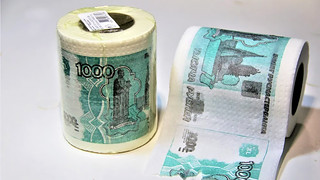 Kavan Ratnatunga writes:
Kavan Ratnatunga writes:
"This reminded me that in October 1989, just before the Soviet Union and its currency collapsed, the Ruble was referred to as Toilet paper by the locals on the Streets of Leningrad."
To read Kavan's article about his 1989 travel to the Soviet Union, see:
1989 October Travel to the Soviet Union
(https://lakdiva.org.lk/travel/1989-10_soviet_union.html)
To read the earlier E-Sylum article, see:
RUSSIA BANS RUBLE TOILET PAPER
(https://www.coinbooks.org/v27/esylum_v27n30a28.html)
The Medal of Honor
Jeff Zarit writes:
"Regarding Baldwin's offering for sale a Medal of Honor, in the past 70 years, more than half of all Medals of Honor were awarded posthumously. Today, there are 70 living recipients.
"Due to the prestige of the Medal of Honor, it is a federal crime to manufacture, sell, or trade these awards without authorization of the federal government. It is also illegal to use unauthorized Medals of Honor to receive benefits, such as money or property.
"Two or three years ago, the German firm Künker had one in an auction. I informed them of the situation and they withdrew the lot. Yes, this is for sale in the UK, in my mind a technicality. The men and women who risked their lives earning this deserve that it will never be treated as a collectible. That is my position."
To read the earlier E-Sylum article, see:
UKRAINIAN AMERICAN'S MEDAL OF HONOR
(https://www.coinbooks.org/v27/esylum_v27n30a27.html)
VOCABULARY TERM: PREMIUM
Here's another entry from Dick Johnson's Encyclopedia of Coin and Medal Terminology. I added the medal image and link to more information. -Editor
Premium. An early award or prize medal (late 18th century), now somewhat obsolete. The word, first used in England in 1601, originally meant a reward or prize (before it took on monetary or insurance meanings). It was thought the British would have been the first to apply the term to prize medals, but the earliest known such medal is the Magellanic Award of the American Philosophical Society – named after Magellan the explorer and established in 1786 – it was originally called the Magellanic Premium.
Also medals established in both countries at the same time bear this out. Count von Rumford (an American-born scientist, Sir Benjamin Thompson, 1753-1814, a physicist who investigated heat and was knighted by George III) established in 1796 the Rumford Prize medal in England at the Royal Society of London and the Rumford Premium in America at the American Academy of Arts and Sciences. (The British medal does not bear the word "premium," the American medal did until 1839 when it was engraved by Moritz Furst and struck at the U.S. Mint; its legend reads: Rumford Medal for Discoveries in Light or Heat; it is Julian AM-1.)
There is also the Scott Premium of the Franklin Institute of Philadelphia, established early 19th century but unused after mid-19th century (Julian AM-19, -20). Few medal programs survive from this period until today and none retain the term "premium" in their name, hence the present obscurity of the term.
References:
O37 {1977} Julian.
For more information, see:
The Magellanic Premium of the American Philosophical Society
(https://www.amphilsoc.org/prizes/magellanic-premium-american-philosophical-society)
To read the complete entry on the Newman Numismatic Portal, see:
Premium
(https://nnp.wustl.edu/library/dictionarydetail/516534)
ANA DOCTOR OF NUMISMATICS ROSTER
Last week Kerry Wetterstrom asked a question I'd been wondering about myself - who are all of the American Numismatic Association honorary Doctor of Numismatics awardees? E-Sylum Feature Writer and American Numismatic Biographies author Pete Smith went one step further, submitting this article on both the awardees and the award's history. Thank you! -Editor
The Cincinnati Numismatic Association presented a Certificate of Award to Waldo C. Moore (1874-1953) on March 23, 1945, which carried the degree of Doctor of Numismatics. Moore had served as the president of the ANA during 1919-1920. His obituary in The Numismatist stated that, "He had made more contributions to our magazine than any other person, living or dead." His title of Doctor of Numismatics carried all the prestige that goes with a certificate from a local club.
Cincinnati continued to be the place to get a doctorate in numismatics. Donald Kagin received that degree in 1979 from the Union Graduate School in Cincinnati. This was an experimental school for non-traditional education. Kagin created the curriculum to be the first student in America to receive that degree. At the time, this was a legitimate academic degree. The Union Institute & University (UI&U) had financial difficulties and permanently closed on June 30, 2024.
In 2008, the ANA presented J. P. Martin and Bill Fivaz with "Doctor of Numismatic" degrees. When two more were presented the following year, they were noted as honorary degrees. The honor came, "with all the rights, privileges and responsibilities which here and everywhere pertain to this degree." Those rights, privileges and responsibilities were not stated.
This is a Summer Seminar thing. Awards are presented at Summer Seminar to Summer Seminar instructors. Announcements of the awards do not mention who selects the people to be honored.
Many people working in numismatics have a Ph,D in some related field. There have been proposals for the ANA to create an academic program to grant degrees in numismatics. Currently there is no way for a student to acquire a Doctor of Numismatic degree through the ANA.
These people have received the honor (possibly not complete):
|
2008 J. P. Martin
2008 Bill Fivaz 2009 Ken Bressett 2009 Mary Sauvain 2010 Don Bonser 2011 Brian Fanton 2011 Tom Mulvaney 2012 Joe Boling 2012 Peter Huntoon 2013 Charles O. Browne |
2013 William Shamhart
2015 John Kraljevich, Jr. 2015 Erik Goldstein 2015 Stephen Carr 2015 Douglas Bird 2016 Bob Campbell 2016 Brian Silman 2017 Kerry Wetterstrom 2017 Fred Schwan 2018 Jerry Bobbe |
2018 Thomas Hallenbeck
2019 Joe Paonessa 2019 Jim Stoutjesdyk 2022 David McCarthy 2022 Steven Feltner 2022 Ricardo de leon Tallavas 2023 Jim Robinson 2023 Mike Ellis 2023 Rod Gillis 2024 Kyle Knapp |
Pete's always quite thorough with his research, but this required looking through a lot of publications across many years. Information can be missed, or perhaps not published in the first place due to a mistake or oversight.
So - can anyone provide updates to this tentative roster? Was an award announced in 2014? Since there were four awards announced in 2015, perhaps this was just an announcement-timing issue.
Many thanks to Pete for pulling this together, and congratulations to all honorees! -Editor
To read the earlier E-Sylum article, see:
KYLE KNAPP AWARDED HONORARY DOCTORATE
(https://www.coinbooks.org/v27/esylum_v27n29a12.html)
NOTES FROM E-SYLUM READERS: JULY 28, 2024 : ANA Doctor of Numismatics Awardees?
(https://www.coinbooks.org/v27/esylum_v27n30a12.html)
STAN KESSELMAN INTERVIEW, PART SEVEN
Greg Bennick's latest interview for the Newman Numismatic Portal is with New York dealer Stan Kesselman. Here's the seventh part, where Stan talks about Harry Bass, Ed Trompeter, Eddie Shapiro, Max Humbert, and uncut sheets of National Bank Notes. -Editor
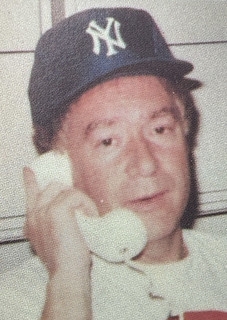 STANLEY KESSELMAN: Let me tell you a little more story about Harry Bass.
STANLEY KESSELMAN: Let me tell you a little more story about Harry Bass.
GREG BENNICK: Please, absolutely.
STANLEY KESSELMAN: Harry Bass married his childhood sweetheart from high school. I think they stayed married for like 40 years, a long time. Then they got divorced. Again, this is, you know, personal lives of successful rich people are not always good. And he suffered for that. He, for a while, would sleep all day. And then he'd be up all night. And he missed the TV programs. So, he'd have, at the time, VCRs going, maybe 15 VCRs at different stations to see what he missed. But he brought up his new fiancée to New York. And we're in the car with her. And he wants to buy her a present.
So, we stopped in front of Tiffany's in New York City, 57th Street and Fifth Avenue. He tells his fiancée, go in there and buy whatever you want. She goes in the store. She's there five minutes, 10 minutes. And Harry's in the car. And Harry says, what do you think she's doing? I said, Harry, she's doing what you told her to do. Buy whatever she wants. So, Harry says, how much is she going to spend? I said, how should I know? You told her to go buy what she wants. And now Harry's getting nervous. He doesn't know what she's going to do.
So we're in the car 20 minutes. She comes out of the store. He opens the door. She gets in. And Harry says, what did you do? She says, I didn't buy anything. I couldn't make up my mind what to do. And Harry says, Stanley, start driving. And he ended up, she was smarter than everybody. She ended up marrying him. And they got married. I imagine she spent $100,000 on a ring. He said, this girl's not for me.
GREG BENNICK: Yeah, right.
STANLEY KESSELMAN: So, she played her cards 100% correct by buying nothing.
GREG BENNICK: That's amazing. That's amazing. So, is there anyone else from your memory that were players in the industry or friends of yours that you might have stories about?
STANLEY KESSELMAN: I remember one about Ed Trompeter. Ed Trompeter was a big, big collector of proof gold coins. And he was in California. He had a wonderful business where he'd sell parts, metal parts, screws, and connectors that cost him $0.09. And he'd get a hell of a lot of money, more than $0.09. So he had Trompeter Electronics was his company. And we just bought from John Morrell his early fives. And Ed Trompeter was in Dallas. And John Morrell is in Dallas. And I'm in Dallas. And Michael Brownlee's in Dallas. So, we need money to pay John Morrell for his early fives. So why not sell them to Ed Trompeter?
So, we went out for dinner. Michael, Ed Trompeter, and I. And Michael and Ed Trompeter are sitting on top of each other almost. They have their arms around each other. And Ed Trompeter is smoking a cigar. And he takes a few puffs. Takes that out of his mouth. And blows the smoke out. And the smoke goes into Michael's face. And Michael is talking and coughing. And his face is turning white. And he's got more smoke. He's coughing more. But Michael doesn't say anything. Like, get rid of that stupid cigar or whatever. Because he wanted Ed Trompeter to buy the coins. So, the more smoke Michael got, the more polite he was. And it ended up that Ed Trompeter took three coins back to California. And one of them was an 1819 half eagle in 65.
John Moreau had beautiful coins. And the other two, I can't remember. But even then, it was hundreds of thousands of dollars. And Michael's happy. I'm happy. And then three days later, the coins come back in the mail. And the Goldbergs, who were Trompeter's advisor, said they were very much overpriced. And Trompeter sent them back.
GREG BENNICK: Oh, wow.
STANLEY KESSELMAN: So, Michael was very happy. He was really angry. For two reasons. First, we needed the money. And number two, of all the abuse he took with the smoke in his face.
GREG BENNICK: He breathed all the smoke in his face.
STANLEY KESSELMAN: Right. And I told him, don't worry about it. We took the coins up to New York to Paul Nugget at MTB. And he bought the three coins, one, two, three, and paid us more money.
GREG BENNICK: Good. All right. Well, it worked out all right. With no smoke.
STANLEY KESSELMAN: With no smoke. Right. And, you know, we eventually ended up selling the coins. A lot ended up, again, with Mack Pogue and his collection.
GREG BENNICK: With the Pogue's, sure.
STANLEY KESSELMAN: Yeah. And they did very well in their sale.
GREG BENNICK: Great. Any other people come to mind other than Ed Trompeter? You knew Eddie Shapiro as well. Is that right?
STANLEY KESSELMAN: Eddie Shapiro had a booth in the 47th Street New York Jewelry Exchange. And it was like a very small booth, as a jeweler would have. And he'd deal only in gold coins. And he was the richest person in the world, friendly to everybody. He used to work on the railroad. And he'd go from town to town. And when he stopped over, he'd go buy coins from people. But he had a lot of money for some reason for the day, paid for things instantly. And it was a wonderful personality. And he brought coins back from Europe.
And when he bought coins from Europe, he went to the European banks. He didn't care what year it was, what date it was, what mint mark it was. And that's where he made a lot of money. And he was happy to sell them at wholesale to get his money back.
And Tire Mountain International, Max Humbert, ran it. He did a lot of business over in banks. He had one person there permanently. And I remember Max offered me six 1921 twenties at one time. He had 1891 CC twenties. Beautiful coins that he sold for like $325 each. They were all pretty much uncirculated. But what he did, he took a lot of the uncirculated coins and marked them down to AU and lowered the price so he can sell more. Even though they were uncirculated, he undergraded them to get rid of them. And they were going $325 each. The 1891 CC had like a 5,000 mintage, but the coin was plentiful. It was almost like a hoard coin.
And today, they probably sell $20,000, $30,000, $40,000 for nice ones, singly. People don't care about rarity and how rare the thing is. Totally rare. And then with Ed Trompeter, going back to him, I sold him his last proof gold coin to finish his whole proof set.
GREG BENNICK: Really?
STANLEY KESSELMAN: Yeah. It was an 1874 Eagle. Beautiful proof. I bought it. I can't remember where, but I know it's the only one I ever had. The coin is 20 struck. And I doubt there's more than five that exist. And it's somewhat unappreciated. Even one just sold for like $300,000 at auction in the last 12 months. But he complained that I charged him too much. And I wanted to get even for the smoke he blew in Michael's face.
GREG BENNICK: Now, with Eddie Shapiro, did he deal with just coins or was there paper money as well that he dabbled in and explored?
STANLEY KESSELMAN: Yeah, he had, I was in his bank vault, which he did business at. He never had a store. He just had people coming every hour to his bank vault to make appointments. And I guess the bank didn't care. And he paid some people to the vault some money. I was there once and he had currency sheets. 1929 currency sheets and they were stacked on top of each other. And I didn't know what they were. And he shows them to me. They have names, numbers, towns, and states. And I asked him what it was. He says he just bought this lot. The face value was $55,000. I said, "What'd you pay?" He said $55,000. But at that time, $55,000 to me was a fortune. And here he has this lying there doing nothing.
And I liked him very much. They looked good. He had a $100 sheet, number one. $50 sheet, number one. Tons of $20 sheets, $10 sheets, $5 sheets. But I didn't know anything about them. So, he finally put them in a Lester Merkin sale, I think it was 1972. And it made multiples of $55. So, when I accumulated more money, I started getting interested in them, and I started to buy them. And I bought maybe 75 sheets. And I sold all 75 sheets to Ted Naftzger. I had a hoard of Reno, Nevada sheets. Maybe 30, 40 sheets from Reno, Nevada that I sold to Ted Naftzger as a group. He liked buying those kind of things.
And I'll never forget this also with Ted Naftzger. I had $31,000 bills, singles, 1934. That were beautiful, uncirculated. And I sold it to Ted Naftzger for $30,000 face value.
GREG BENNICK: Wow.
STANLEY KESSELMAN: And he loved that. So, you know, he liked the big denomination. He probably gave them away. I don't know. They make very good Christmas gifts. Now an uncirculated $1,000 bill, I think is around $10,000. It was nice.
GREG BENNICK: Wow. Very cool.
STANLEY KESSELMAN: Yeah. So those were days, you know, that you bring back. I remember from William Donner, who was also an importer of gold coins. He had an 1870 CC half Eagle. Beautiful coin that I paid maybe $3,000 for a beautiful coin. You know, it's worth, I don't know, over a hundred thousand easy now because of the condition. It's just, you know, it's hard to compete in days like this where the coins are so expensive compared to where they were.
But again, it's not, I contend it's not the coins that went up. It's the money to buy them with became so much more plentiful, so much more plentiful. Warren Buffett was on TV today with his annual meeting for five hours. And he remembers more of the mistakes he made, not of the profits he made. He said he learned more from his mistakes than when he did doing things right. You know, so I sort of take that philosophy myself, you know, you know, but it's, you know, it's a wonderful hobby. You meet wonderful people.
The best thing is that people come from all over the country, different politics, different voice, different accents. And today, you know, that's important, you meet people from everywhere, from Midwest, from Texas, from California, from New Hampshire, wherever you are, because where people live, they have different points of view for sure. And we don't meet enough of Americans from different places. All we do is somewhat stay home and meet the same kind of people with the same views all the time, which is, you know, somewhat of a tragedy.
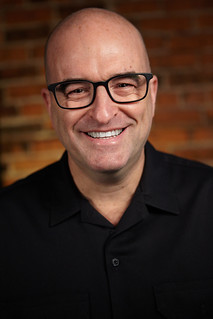 About the Interviewer
About the Interviewer
Greg Bennick (www.gregbennick.com) is a keynote speaker and long time coin collector with a focus on major mint error coins. Have ideas for other interviewees? Contact him anytime on the web or via instagram @minterrors.
To watch the complete video, see:
Stanley Kesselman Interviewed for the NNP by Greg Bennick
(https://nnp.wustl.edu/library/book/638521)
To read the complete transcript, see:
Stanley Kesselman Interviewed for the NNP by Greg Bennick (Transcript)
(https://nnp.wustl.edu/library/book/638520)
To read the earlier E-Sylum article, see:
STANLEY KESSELMAN INTERVIEW, PART ONE
(https://www.coinbooks.org/v27/esylum_v27n25a06.html)
STANLEY KESSELMAN INTERVIEW, PART TWO
(https://www.coinbooks.org/v27/esylum_v27n26a13.html)
STANLEY KESSELMAN INTERVIEW, PART THREE
(https://www.coinbooks.org/v27/esylum_v27n27a11.html)
STANLEY KESSELMAN INTERVIEW, PART FOUR
(https://www.coinbooks.org/v27/esylum_v27n28a17.html)
STANLEY KESSELMAN INTERVIEW, PART FIVE
(https://www.coinbooks.org/v27/esylum_v27n29a18.html)
STANLEY KESSELMAN INTERVIEW, PART SIX
(https://www.coinbooks.org/v27/esylum_v27n30a19.html)
ERIC SCHENA INTERVIEW, PART FOUR
Greg Bennick also interviewed exonumia researcher and collector Eric Schena. Here's the fourth part, where Eric talks about panic money, mintages of local tokens, and cherrypicking examples from antique shops. -Editor
GREG BENNICK: And we can. We'll do more. Let's talk about emergency money or panic money, because that's something that you've mentioned to me, that if you said to me, "Greg, tell me everything you know about emergency or panic money," I'd say, "I just did. I asked you the question. That's all I know." So, tell me and tell us about emergency money or panic money.
 ERIC SCHENA: Well, panic money is interesting stuff. This is another form of making do. I don't know if you remember some years ago during the dot-com crisis around the time, 2008 or so, California ran out of money to pay their, they didn't run out of money, but they ran out of ways to pay their staff and they started handing out vouchers. That is technically panic money. Because we were in a panic and what was traditionally called a panic, but back then, the dot-com recession or whatever you want to call it… that was a form of panic scrip. The first, best known, it's kind of funny, these panics happen in usually in 25-year patterns. There was a panic in 1819, one in 1837, best known as the Hard Times, the panic of 1857, panic of 1873, another one in 1893, and then the big one, which was a panic in 1907.
ERIC SCHENA: Well, panic money is interesting stuff. This is another form of making do. I don't know if you remember some years ago during the dot-com crisis around the time, 2008 or so, California ran out of money to pay their, they didn't run out of money, but they ran out of ways to pay their staff and they started handing out vouchers. That is technically panic money. Because we were in a panic and what was traditionally called a panic, but back then, the dot-com recession or whatever you want to call it… that was a form of panic scrip. The first, best known, it's kind of funny, these panics happen in usually in 25-year patterns. There was a panic in 1819, one in 1837, best known as the Hard Times, the panic of 1857, panic of 1873, another one in 1893, and then the big one, which was a panic in 1907.
And then after that, they became known as depressions in 1929, that period, the Great Depression. That's a panic. That was would be technically considered an economic panic on the same definition. A lot of panic scrip was issued because the money supply contracted so much so that people couldn't get their money or the banks were forced to be closed.
Roosevelt had very famously had the bank holiday just as soon as he took office in March of 1933. He closed the banks, mandatory bank holiday. There are people that need to get paid. And how did you pay them? How did these local businesses get paid? They came up with ersatz money. Many places went to the local newspaper shop, ordered up some scrip. Many communities did that too. Banks would gather together in clearinghouse associations and issue that kind of money and individual businesses… This coal scrip, this is actually a gold mining scrip. This is panic money.
This particular bank, I should say mine, the Gold Mountain Consolidated Mining Company, ran out of money to pay its miners. And had no way of getting that money from Richfield, Utah. So, they just quickly ran up some scrip and they paid it to their miners with due dates on it. Like, for instance, this one was payable on August 10th in 1908. This particular one right here. And so that's what they were. It was a form of circulating IOU. And a lot of this stuff was intended not to be saved. I mean, this is, this is not very decorative stuff. It's just words. It's purely utilitarian.
And many times, that was the case. In 1893, there was a monetary shortage in Virginia in particular. Around the tobacco fields. There was a bumper crop of tobacco. And there was of course, the banking contraction of 1893. And so, there was no money for the tobacco warehouses to buy product from the farmers. So, they issued a lot of the banking clearinghouses - Danville is the one that immediately comes to mind - issued their own scrip that would be payable later on. And it circulated as money. And they were not intended to be saved. And survival of this stuff is purely by chance because of that.
Those California vouchers from, you know, that's only about 15, 20 years ago. I've never seen one. They were not meant to; they were not meant to be saved. They were meant to be used and redeemed.
GREG BENNICK: And once redeemed, probably not saved by the issuing body.
ERIC SCHENA: Exactly. Especially in this particular day and age where paper files are not as important to maintain, probably destroyed. I'm sure there's some of those vouchers still around. It was to California public employees, if I remember correctly. But I've never seen one. But that stuff exists and I find it eminently fascinating. And it's rare as hell too. If you think about it, how many 1909-S VDB pennies have you seen? They're expensive. They're popular, but you can always get one and you can always get one even up into MS-64, MS-65, MS-66.
GREG BENNICK: Absolutely.
ERIC SCHENA: When was the last time you saw a token from Frisco, Utah?
GREG BENNICK: I didn't even know there was such a thing. Again, goosebumps for the first time in a Newman Numismatic Portal interview, because you mentioned that one even exists. Now I'm obsessing about it in my mind that I need to find one someday.
ERIC SCHENA: Yeah, they do. They do exist, but they're handfuls. They weren't struck in high quantity. If a store issued more than say 2000 or 3000 tokens, that was an average, if not a little higher than average. So, we're talking about minuscule amounts of these tokens. There's the Ingle Schierloh records. Ingle Schierloh was a, was a scrip manufacturer that was in business for quite a number of years in the first half of the 20th century. And their records still exist. They have minting records.
So, they will have entries in them saying the name of the customer, the location of the customer, the denominations that they wanted, the little cutouts that they wanted in the tokens and how many were struck by the die sinker, and by the mint. And there are records in there of 100 of one particular denomination or 200 to 300. We're not talking about large quantities of these things. And when you consider that they weren't meant to be saved, even fewer are around nowadays. So, a lot of that stuff only survives by happenstance.
GREG BENNICK: It's so interesting because it really reframes rarity, right? You know, there's some obviously classic American numismatic rarities of unparalleled order where there's one of, or that sort of thing. But then even the normal or average well-known classic numismatic rarities: the 1916 Standing Liberty quarter, or like you said, the 1909-S VDB cent. These are minted in the order of tens of thousands or a hundred thousand. But when we're talking about, for example, a counterstamp issued by a merchant, there might be 10 known or 15 or 20 known or what you're talking about, thousands made, 150 years ago of which how many remain? Hardly any.
ERIC SCHENA: Yeah, exactly. Here's a token from a place called Shooting Creek, Virginia. It's in Floyd County. One of only two known. This is rarer than an 1804 dollar. It's rarer than a 1913 V nickel. I didn't pay four and a half million dollars for it. (laughs)
GREG BENNICK: Well, that's what's interesting to me, right. Is that some of these more obscure for lack of a better term areas of numismatics or, you know, collecting, yield opportunities for people to acquire rarities on tall or high orders, which don't require vast bank accounts in order to purchase. Like chances of me owning a 1913 nickel? Pretty slim. Chance of me owning a token that of which there are five known? Pretty good. You know, there's a chance of that.
ERIC SCHENA: They are pretty good. And what's really funny is you can sometimes get them dirt cheap - those very rare tokens. My wife Heather has a fantastic eye for finding these things. She's from Southwest Virginia and she would go down and look in some of the antique stores and she would find all sorts of great tokens. She found this one token from a place called Mayberry. Now, that's a very familiar name to a lot of people and in fact it does have a connection to that tv show.
Mayberry is located in Patrick County Virginia. It is actually on the Blue Ridge Parkway and it's only about 20 or so miles away from Mount Airy, where Andy Griffith is from and he modeled Mayberry on the tv show off of Mount Airy. But he actually to the woman who played his girlfriend on the show - I can't remember her name to save my life and I feel bad about that. He actually told her that he would visit the general store in Mayberry Virginia with his grandfather and they had an account there and that's where he grabbed the name from, Mayberry in Patrick County Virginia. As far as I know that is a unique token on that denomination – it's one of two known. There's another from the merchant, but it's on a different denomination. Merchant's name was I.T. Banks, and it's unique. Heather paid 10 bucks for it.
GREG BENNICK: Incredible, I love it, I love it. It's just, it's always fascinated me and that's why one of the reasons I enjoy this so much. It is just exploring new areas that a people are interested in, but also remembering that we all like these obscure things, but that are actually quite meaningful. Meaning that what you just described isn't just some bizarre interesting fascinating weird collecting subset. It's, it's a piece of history that actually has a connection to Hollywood, to television, to popular culture all in the form of something that costs ten dollars that you can fit in the palm of your hand.
ERIC SCHENA: Yeah, it was ten dollars and it came out of an antique store in Vesta, Virginia, also in Patrick County.
GREG BENNICK: Unbelievable.
ERIC SCHENA: Yeah, that's the kind of history that you go around and you try to preserve and here's the fun, actually not so much fun as it is important: the important thing is that finding these tokens is important. In some cases, if you have one or two known of those tokens, that's the only piece of evidence nowadays of that store. A lot of those stores, they were built in vernacular buildings that were not intended to last. Many times, they go through several ownership changes and the ownership changes get forgotten in the mists of history. A lot of times having those tokens is one of the few tangible items from that. This goes back to another numismatic aspect of mine. I also do ancient coins, ancient and medieval.
GREG BENNICK: Yes, I was going to ask.
 About the Interviewer
About the Interviewer
Greg Bennick (www.gregbennick.com) is a keynote speaker and long time coin collector with a focus on major mint error coins. Have ideas for other interviewees? Contact him anytime on the web or via instagram @minterrors.
To watch the complete video, see:
Eric Schena Interviewed for the NNP by Greg Bennick
(https://nnp.wustl.edu/library/book/639081)
To read the complete transcript, see:
Eric Schena Interviewed for the NNP by Greg Bennick (Transcript)
(https://nnp.wustl.edu/library/book/639095)
To read the earlier E-Sylum article, see:
ERIC SCHENA INTERVIEW, PART ONE
(https://www.coinbooks.org/v27/esylum_v27n28a18.html)
ERIC SCHENA INTERVIEW, PART TWO
(https://www.coinbooks.org/v27/esylum_v27n29a19.html)
ERIC SCHENA INTERVIEW, PART THREE
(https://www.coinbooks.org/v27/esylum_v27n30a20.html)
NUMISMAGRAM MEDAL SELECTIONS: AUGUST 4, 2024
Jeremy Bostwick at Numismagram sent along these five medals from his upload of new material to his site. For all of the new items, please visit https://www.numismagram.com/inventory. -Editor
102586 | GERMANY. Confirmation silver Medal. Issued circa 1820-1855 (36mm, 14.00 g, 12h). By L. Herd for the Loos workshop in Berlin. HERR ICH LASSE DICH NICHT DU SEGNEST MICH DENN (Lord, I will not go unless You bless me, —adapted from Genesis 32:26), child advancing right, reaching up toward Christ standing left; 1 B MOS 32 V 26 in exergue // HALT IM GEDAECHTNISS JESUM CHRISTUM (Always remember that Jesus Christ, a descendant of King David, was raised from the dead, —adapted from 2 Timothy 2:8), draped altar bearing crucifix between chalice and plate; 2 TIMOTH 2 V 8 in exergue. Edge: Plain. Cf. Sommer B3 (for overall type) & B9 (rev.)/B10 (rev.) (for this specific type); GPH –. PCGS SP-62. Highly flashy and brilliant, with some deep iridescence nearer the peripheries. Exceeded by just two others in the PCGS census, though by just one of this specific type. $395.
To read the complete item description, see:
102586 | GERMANY. Confirmation silver Medal.
(https://www.numismagram.com/product-page/102586)
102731 | GERMANY. Baptism silver Medal. Issued circa 1875-1900 (38mm, 16.32 g, 12h). By "L.W. & C." DIESER IST MEIN LIEBER SOHN (this is my dear son, adapted from Luke (9:35), Christ standing right in the River Jordan, with head lowered and hands crossed on chest, being baptized by John the Baptist standing left, holding dish and long cross; mountainscape in background, radiant dive above // DURCH DIE AUFLEGUNG IHRER HANBE EMPFINGEN SIE DEN HEILIGEN GEIST (the Spirit was given when the apostles laid their hands on people, —adapted from Acts 8:18), radiant dove within elaborate border. Edge: Plain. GPH –. PCGS SP-64. Extremely lustrous and lightly toned. The only such example of the type in the PCGS census. $325.
To read the complete item description, see:
102731 | GERMANY. Baptism silver Medal.
(https://www.numismagram.com/product-page/102731)
102875 | AUSTRIA. Sigmund Freud bronze Medal. Issued 1906 for the 50th birthday of the founder of psychoanalysis (59mm, 99.70 g, 12h). By C. M. Schwerdtner, Jr. at the Vienna mint. SIEGMVND FREVD WIEN MCMVI, bust right // The Riddle of the Sphinx: nude Oedipus standing left, resting head in hand and holding walking stick; to left, forepart of Sphinx right; to right, ‘OS TA KLEINP' / AINII MAT ‘HI?EI / KAI KPATISTOS ‘HN ANHP (what goes on four feet in the morning, two feet at noon, and three feet in the evening?). Edge: MÜNZE WIEN. Wurzbach 2797; Storer 1127; Optica et Visio in Nummis IV.261 var. (silver). Choice Mint State. Brown-bronze surfaces, with some great brilliance. Compare to a similar example that realized a total of $450 in Classical Numismatic Group E-535, lot 748. $265.
To read the complete item description, see:
102875 | AUSTRIA. Sigmund Freud bronze Medal.
(https://www.numismagram.com/product-page/102875)
102850 | GERMANY & RUSSIA. Carnival cast bronze Medal. Dated 1919. "Fasching"—on the carnival that should not be celebrated (58mm, 68.49 g, 12h). By K. Goetz in München. IM OSTEN DIE NEUE GEFAHR (a new danger in the East), facing bearded serpentine demonic head, with serpent-entwined bombs to left and right, and banner reading BOLSCHIWISMUS (Bolshevism) below // FASCHING, Germany (represented by the German eagle's head facing right) under the influence of agitators: her beak is padlocked, her talons are being plucked out with pliers by a British soldier, while a French and Chinese soldier look on; to upper left, German workers are forced to work ever harder in order to fulfil reparations; above, German citizens falsely dance in revelry under a pseudo liberty tree, surmounted by a phrygian cap. Edge: Casting pit as made, otherwise plain. Kienast 223. Choice Mint State. Warm brown surfaces. $695.
To read the complete item description, see:
102850 | GERMANY & RUSSIA. Carnival cast bronze Medal.
(https://www.numismagram.com/product-page/102850)
102871 | NETHERLANDS. Karel Frederik Wenkenbach bronze Medal. Issued 1934. Commemorating the 70th birthday of the cardiologist, anatomist, and professor of medicine (50mm, 51.07 g, 12h). By O. Wenckebach. • KAREL • FREDERIK • WENCKEBACH • / AET • 70, bare head left // OMNI CURA TUERE CORTUUM NAM EX EO VITAE EST ORIGO (protect your heart with all your care, for that is the origin of life), human heart. Edge: Plain. Hofstee 28. Choice Mint State. Slightly mottled olive-brown surfaces. Splendid and rare Medicina in Nummis type. $325.
To read the complete item description, see:
102871 | NETHERLANDS. Karel Frederik Wenkenbach bronze Medal.
(https://www.numismagram.com/product-page/102871)
SYD MARTIN COLLECTION PART IV HIGHLIGHTS
Here are some highlights from the upcoming Stack's Bowers sale of the Syd Martin Collection, Part IV. Great coins and medals. -Editor
1781 (1789) Daniel Morgan at Cowpens Medal. Original Dies. Betts-593. Copper.
Morgan continues to make history in the numismatic realm every time one of these is offered. The gold medal struck at the United States Mint in 1839 for Morgan's grandson as a replacement for the lost gold original brought $960,000 in our sale of April 2022. It holds the record for most valuable American medal ever sold. We have handled every single original Daniel Morgan at Cowpens medal sold at auction. There are just four in private hands:
To read the complete lot description, see:
1781 (1789) Daniel Morgan at Cowpens Medal. Original Dies. Betts-593. Copper. Specimen-62 BN (PCGS).
(https://auctions.stacksbowers.com/lots/view/3-1B9EUZ/1781-1789-daniel-morgan-at-cowpens-medal-original-dies-betts-593-copper-specimen-62-bn-pcgs)
1787 Columbia and Washington Medal. Copper. Plain Edge.
A beautiful example of one of America's most important early medals, struck to mark the voyage of the first American vessels to visit the American west coast.
To read the complete lot description, see:
1787 Columbia and Washington Medal. Copper. Plain Edge. VF-30 (PCGS).
(https://auctions.stacksbowers.com/lots/view/3-1B9EXS/1787-columbia-and-washington-medal-copper-plain-edge-vf-30-pcgs)
Undated (1659) Lord Baltimore Shilling. Hodder 1-A, W-1080. Rarity-6. Large Bust, MARIAE.
One of the very nicest survivors of this important issue, the first silver coin produced abroad exclusively for American circulation.
To read the complete lot description, see:
Undated (1659) Lord Baltimore Shilling. Hodder 1-A, W-1080. Rarity-6. Large Bust, MARIAE. AU-55 (PCGS).
(https://auctions.stacksbowers.com/lots/view/3-1B9FKS/undated-1659-lord-baltimore-shilling-hodder-1-a-w-1080-rarity-6-large-bust-mariae-au-55-pcgs)
1773 Virginia "Penny." Newman 1-A, W-1390. Rarity-6.
Struck on highly prepared planchets from a unique set of dies, the Virginia "penny" coins were never intended for commerce. While a few are known with evidence of circulation, most are fairly nice, well-preserved in the upper class 18th century English collections for which they were intended.
To read the complete lot description, see:
1773 Virginia "Penny." Newman 1-A, W-1390. Rarity-6. Proof. Unc Details--Damage (PCGS).
(https://auctions.stacksbowers.com/lots/view/3-1B9FR5/1773-virginia-penny-newman-1-a-w-1390-rarity-6-proof-unc-details-damage-pcgs)
1787 Connecticut Copper. Miller 32.2-X.1, W-3220. Rarity-2. Draped Bust Left.
Across nearly two decades of auction archives, we have sold only a single example of this variety in Mint State, that being Syd Martin's primary coin in August 2023-the finest known. This is another remarkable survivor, and though the variety is relatively common, Mint State coins are extremely rare. In fact, the Heritage archives, which have far fewer records than our own but include the landmark Partrick and Newman holdings, include only this piece as a Mint State entry.
To read the complete lot description, see:
1787 Connecticut Copper. Miller 32.2-X.1, W-3220. Rarity-2. Draped Bust Left. MS-63 BN (PCGS).
(https://auctions.stacksbowers.com/lots/view/3-1B9IS6/1787-connecticut-copper-miller-322-x1-w-3220-rarity-2-draped-bust-left-ms-63-bn-pcgs)
To read the earlier E-Sylum articles, see:
STACK'S BOWERS TO SELL SYD MARTIN COLLECTION
(https://www.coinbooks.org/v25/esylum_v25n02a19.html)
SYD MARTIN COLLECTION PART III HIGHLIGHTS
(https://www.coinbooks.org/v26/esylum_v26n11a21.html)
MORE MARTIN COLLECTION PART III HIGHLIGHTS
(https://www.coinbooks.org/v26/esylum_v26n12a24.html)
SBG OFFERS BANCO DE MEXICO NOTES
Stack's Bowers Director of Consignments & Senior Numismatist Dennis Hengeveld published this article about paper money of Mexico's Central Bank in the firm's August 2024 sale. -Editor
The Banco de Mexico, Mexico's Central Bank, was finally created on August 25, 1925, after a century of attempts to do so. It was formed eight years after the passing of Mexico's constitution, which included a clause that all paper money was to be issued by a single government entity. Four years earlier, in April of 1921, a contract had been signed by the Mexican government (already representing the future Banco de Mexico) and the American Bank Note Company of New York to print bank notes in denominations ranging from 5 Pesos to 1000 Pesos. The contract further stipulated that the notes "shall be from the best quality plates, engraved in the best current style."
This series of banknotes became the first for the newly formed Banco de Mexico when it first commenced operations in 1925. The notes were nicknamed "Los Anchos" or "the Wide Ones," due to their 3 x 7 inch size. It was expected that acceptance of paper money by the general public of Mexico would be difficult due to the plethora of bank note issues during the Mexican revolution Many of those were not honored afterwards, causing distrust in paper money in general. To prevent this the bank notes were redeemable in gold coin held in the vaults of the Bank of Mexico, which helped acceptance and made the circulation of this series a success.
The first series of the Banco de Mexico is listed in the Pick catalog as Pick-21 through Pick-27. The series would be issued until the mid-1930s with a variety of different dates (and some denominations also without dates) and utilized a wide variety of designs. The front features various vignettes, including a gypsy girl and several allegories, while the back of all denominations is similar, showing the Angel of Independence Monument in Mexico City.
The August 2024 Global Showcase Auction of World Paper Money (Session A) offers an advanced group from this iconic series, including elusive dates seldom seen at public auction as well as notes that are the sole example of that date in the PMG population report. Highlights include:
Stack's Bowers Galleries is always accepting consignments for upcoming sales. To start the consignment process, please contact Stack's Bowers Galleries at 800-458-4646 or email Dennis Hengeveld at Dennis@stacksbowers.com.
To read the complete article, see:
AUGUST GLOBAL SHOWCASE AUCTION OFFERS ICONIC NOTES FROM BANCO DE MEXICO
(https://stacksbowers.com/august-global-showcase-auction-offers-iconic-notes-from-banco-de-mexico/)
1900 $10,000 GOLD CERTIFICATE OFFERED
Stack's Bowers is offering a nice example of the 1900 $10,000 Gold certificate. Here's an article by SBG Numismatist & Lead Currency Cataloger Bradley Charles Trotter. -Editor
Thrown recklessly into the street to deprive a fire of fuel, notes like this one, found in lot 21346 of our August auction, are a common sight at auction and in numismatic circles. Frequently found displaying the engraved signatures of Teehee and Burke, most examples display evidence of the event which led to their unlikely survival.
Evidence of water damage or even burn marks are unsightly reminders of this event on most such notes. However, a handful of examples like this one are known and give collectors the chance to acquire such a revered denomination for less than face value.
Featuring the engraved signatures of Register John C. Napier and Treasurer Lee McClung, this piece displays the cancellations typical of its peers, but is in scarce company as the finest example recorded in the PMG Population Report with an assigned grade of Choice About Uncirculated 58. It is also among the fewer than two dozen individual pieces recorded by Track & Price.
The cancellations which spell out "PAID *9:25:12* Phila" are seen in conjunction with a pair of imprints from the Philadelphia Clearing House Association and the Tradesmens National Bank of Philadelphia (Charter# 570) along with signatures from representatives of those institutions. The signature associated with the Tradesmens National Bank is that of Edmund Williams who later served as cashier from 1919 to 1927. The portrait of Andrew Jackson, seen at left opposite the obligation and rightmost denomination counter, has borne the brunt of these cancellations.
A testament to numismatic history, this item is more than just another note that can trace its provenance to this storied event, but one that is also exceptional. If you wish to build a first-rate type set of Friedberg numbers, this is an opportunity decades in the making and one without precedent at auction.
To read the complete article, see:
FINEST KNOWN FR. 1225E 1900 $10,000 GOLD CERTIFICATE TO BE OFFERED IN AUGUST GLOBAL SHOWCASE AUCTION
(https://stacksbowers.com/finest-known-fr-1225e-1900-10000-gold-certificate-to-be-offered-in-august-global-showcase-auction/)
Garrett Ziss located this anonymous PMG article with more information on the fire. Thanks. -Editor
Numismatic lore and many auction descriptions tell the story of a fire at the then "new" Washington, DC Post Office at 12th and Pennsylvania on Friday December 13, 1935. During this event, many government records were tossed out of the sixth floor windows and into the street below, and among these records were several hundred cancelled $10,000 gold certificates. Many onlookers picked the notes up and took them home. This is the accepted explanation behind why many are found with moisture stains and a few with charring.
Newspaper accounts of the day tell us that this was one of the most unusual fires in the history of Washington, DC. The first alarm occurred shortly after midnight. The fire started in a large filing room on the sixth floor that was crammed full of flammable material, then spreading to other similar filing rooms. Hoses had to be hauled into fifth floor windows with the help of ropes and then dragged through the corridors and up the stairs to the sixth floor. These filing rooms were locked, so axes and crowbars were employed to break the doors down. Eventually, the fire would go to five alarms and fire departments as far away as Virginia and Maryland responded.
The filing rooms lacked sprinkler systems and ventilation, requiring walls and floors to be breached to let the smoke out. A lack of gas masks caused 41 firemen to be overcome with smoke and taken to the hospital. Luckily, all of them would recover. In the meantime, a crowd of several thousand assembled in the street below. Files of the General Accounting Office, plus files from other government agencies were thrown out of windows (the sixth floor only had windows along one side), in order to deny the fire future nourishment. This is when the Series 1900 cancelled $10,000 Gold Certificates rained down on the lucky onlookers and eventually into the numismatic community.
To read the complete article, see:
Friedberg 1225 - the Series 1900 $10,000
(https://www.pmgnotes.com/news/article/2816/Friedberg-1225-andmdash-the-Series-1900-10000/)
KEUSCH COLLECTION OF ASSAY MEDALS
Stack's Bowers has an extensive offering of Assay Commission medals in their August 2024 Global Showcase Auction. Here are some selected lots. -Editor
The Keusch Collection of Assay Commission Medals was the greatest and most extensive collection ever formed of these esoteric and rare medals. We were honored to present that cabinet at auction in November 2008. This August, we are fortunate to be able to offer again a large group of these medals from a private collector who bought extensively from that sale. Many are exceedingly rare and the finest known of their types. View the entire offering here.
To read the complete item description, see:
1869 United States Assay Commission Medal. JK AC-5. Rarity-5. No Stars. Aluminum.
(https://auctions.stacksbowers.com/lots/view/3-1BD797/1869-united-states-assay-commission-medal-jk-ac-5-rarity-5-no-stars-aluminum-specimen-65-pcgs)
To read the complete item description, see:
1869 United States Assay Commission Medal Mule. JK AC-7. Rarity-8. Columbia. Aluminum.
(https://auctions.stacksbowers.com/lots/view/3-1BD79X/1869-united-states-assay-commission-medal-mule-jk-ac-7-rarity-8-columbia-aluminum-specimen-63-pcgs)
To read the complete item description, see:
1872 United States Assay Commission Medal. JK AC-11. Rarity-6. Silver.
(https://auctions.stacksbowers.com/lots/view/3-1BD7C3/1872-united-states-assay-commission-medal-jk-ac-11-rarity-6-silver-specimen-64-pcgs)
To read the complete item description, see:
1880 Pattern United States Assay Commission Medal. JK AC-22. Rarity-6. Copper, Bronzed.
(https://auctions.stacksbowers.com/lots/view/3-1BD7GP/1880-pattern-united-states-assay-commission-medal-jk-ac-22-rarity-6-copper-bronzed-specimen-65-bn-pcgs)
To read the complete item description, see:
1902 United States Assay Commission Medal. JK AC-46. Rarity-5. Silver.
(https://auctions.stacksbowers.com/lots/view/3-1BD7Q8/1902-united-states-assay-commission-medal-jk-ac-46-rarity-5-silver-specimen-63-pcgs)
To read the complete item description, see:
1904 United States Assay Commission Medal. JK AC-48. Rarity-5. Silver.
(https://auctions.stacksbowers.com/lots/view/3-1BD7QW/1904-united-states-assay-commission-medal-jk-ac-48-rarity-5-silver-specimen-62-pcgs)


Lot 4135
1915 United States Assay Commission Medal. JK AC-59. Rarity-7. Silver. Presented to John Skelton Williams.
To read the complete item description, see:
1915 United States Assay Commission Medal. JK AC-59. Rarity-7. Silver. Presented to John Skelton Williams.
(https://auctions.stacksbowers.com/lots/view/3-1BD7UK/1915-united-states-assay-commission-medal-jk-ac-59-rarity-7-silver-presented-to-john-skelton-williams-specimen-65-pcgs)


Lot 4154
1934 United States Assay Commission Medal. JK AC-79. Rarity-4. Bronze. Presented to Wm. R. Siner.
To read the complete item description, see:
1934 United States Assay Commission Medal. JK AC-79. Rarity-4. Bronze. Presented to Wm. R. Siner.
(https://auctions.stacksbowers.com/lots/view/3-1BD82C/1934-united-states-assay-commission-medal-jk-ac-79-rarity-4-bronze-presented-to-wm-r-siner-specimen-65-pcgs)
To read the complete item description, see:
1958 United States Assay Commission Medal. JK AC-102. Rarity-7. Bronze.
(https://auctions.stacksbowers.com/lots/view/3-1BD84L/1958-united-states-assay-commission-medal-jk-ac-102-rarity-7-bronze-specimen-66-pcgs)
To read the complete item description, see:
1964 United States Assay Commission Medal. JK AC-108. Rarity-7. Bronze.
(https://auctions.stacksbowers.com/lots/view/3-1BD85B/1964-united-states-assay-commission-medal-jk-ac-108-rarity-7-bronze-specimen-65-pcgs)
THE BOOK BAZARRE
RICHARD MARGOLIS COLLECTION, PART II
Here are some selections from the "French Patterns, Trials & Numismatic Curiosities" in The Richard Margolis Collection, Part II on offer from Stack's Bowers. -Editor
Stack's Bowers is excited and extremely pleased to offer part II of the Richard Margolis Collection in next month's August Global Showcase Auction. This unparalleled array of nearly 350 French lots focuses entirely upon the period beginning with the crowning of Louis XVI and ending with the rise of Napoleon as emperor. Though spanning a mere three decades, this portion of the Margolis collection—a true life's work—touches upon countless numismatic aspects, as it features some of the rarest and unusual patterns, trials, and numismatic curiosities. The vast majority of these treasures emanate from prestigious prior collections and have been off the market for many decades (and, in some instances, over half a century). Embark upon an unrivaled trip through this intriguing period of French numismatic history.


Lot 43327
FRANCE. Consulate. Gold 20 Francs Essai (Pattern), Year XI-A (1802/3).
Paris Mint. Napoléon as First Consul.
To read the complete item description, see:
FRANCE. Consulate. Gold 20 Francs Essai (Pattern), Year XI-A (1802/3). Paris Mint. Napoléon as First Consul.
(https://auctions.stacksbowers.com/lots/view/3-1B9RPX/france-consulate-gold-20-francs-essai-pattern-year-xi-a-18023-paris-mint-napolon-as-first-consul-pcgs-specimen-65-cameo)
To read the complete item description, see:
FRANCE. Kingdom. Écu aux branches d'olivier, 1774-A.
Paris Mint. Louis XVI.
(https://auctions.stacksbowers.com/lots/view/3-1B9MND/france-kingdom-cu-aux-branches-dolivier-1774-a-paris-mint-louis-xvi-pcgs-proof-63)
To read the complete item description, see:
FRANCE. Kingdom. Silver Écu de Calonne Essai (Pattern), 1786.
Paris Mint. Louis XVI.
(https://auctions.stacksbowers.com/lots/view/3-1B9MVS/france-kingdom-silver-cu-de-calonne-essai-pattern-1786-paris-mint-louis-xvi-pcgs-specimen-62)


Lot 43032
FRANCE. Constitution. Silver Écu de 6 Livres Essai (Pattern), Year 2/1791.
Paris Mint. Louis XVI.
To read the complete item description, see:
FRANCE. Constitution. Silver Écu de 6 Livres Essai (Pattern),
Year 2/1791. Paris Mint. Louis XVI.
(https://auctions.stacksbowers.com/lots/view/3-1B9N0E/france-constitution-silver-cu-de-6-livres-essai-pattern-year-21791-paris-mint-louis-xvi-pcgs-specimen-64)


Lot 43060
FRANCE. Constitution. Bell Metal Assignat of 5 Livres with Added Parchment, 1791.
Paris Mint. Louis XVI.
To read the complete item description, see:
FRANCE. Constitution. Bell Metal Assignat of 5 Livres with Added Parchment, 1791. Paris Mint. Louis XVI.
(https://auctions.stacksbowers.com/lots/view/3-1B9NCO/france-constitution-bell-metal-assignat-of-5-livres-with-added-parchment-1791-paris-mint-louis-xvi-pcgs-ms-64)


Lot 43248
FRANCE. National Convention. Reign of Terror. Silver 5 Décimes Essai (Pattern),
Year 2-A (1794). Paris Mint.
To read the complete item description, see:
FRANCE. National Convention. Reign of Terror. Silver 5 Décimes Essai (Pattern), Year 2-A (1794). Paris Mint.
(https://auctions.stacksbowers.com/lots/view/3-1B9QED/france-national-convention-reign-of-terror-silver-5-dcimes-essai-pattern-year-2-a-1794-paris-mint-pcgs-specimen-61)


Lot 43337
FRANCE. Consulate. Silver 5 Francs Essai (Pattern), Year XI (1802/3).
Geneva Mint. Napoléon as First Consul.
To read the complete item description, see:
FRANCE. Consulate. Silver 5 Francs Essai (Pattern), Year XI (1802/3). Geneva Mint. Napoléon as First Consul.
(https://auctions.stacksbowers.com/lots/view/3-1B9RWD/france-consulate-silver-5-francs-essai-pattern-year-xi-18023-geneva-mint-napolon-as-first-consul-pcgs-specimen-62)


Lot 43343
FRANCE. Consulate. Silver 40 Francs Essai (Pattern), Year XII (1803/4).
Paris Mint. Napoléon as First Consul.
To read the complete item description, see:
FRANCE. Consulate. Silver 40 Francs Essai (Pattern), Year XII (1803/4). Paris Mint. Napoléon as First Consul.
(https://auctions.stacksbowers.com/lots/view/3-1B9S0E/france-consulate-silver-40-francs-essai-pattern-year-xii-18034-paris-mint-napolon-as-first-consul-pcgs-specimen-61)


Lot 43346
FRANCE. Consulate. Copper 5 Francs Essai (Pattern), Year XII (1803/4).
Paris Mint. Napoléon as "the Great".
To read the complete item description, see:
FRANCE. Consulate. Copper 5 Francs Essai (Pattern), Year XII (1803/4). Paris Mint. Napoléon as "the Great".
(https://auctions.stacksbowers.com/lots/view/3-1B9S1W/france-consulate-copper-5-francs-essai-pattern-year-xii-18034-paris-mint-napolon-as-the-great-pcgs-specimen-63-brown)
ARCHIVES INTERNATIONAL SALE #96 SELECTIONS
Here are some items that caught my eye in the upcoming Archives International sale. -Editor
Lot 4: Banco de la Provincial Buenos Aires, 1883, "Top Pop" Proof Banknote
Buenos Aires, Argentina, 1883. 20 Centesimos Oro, P-S533p, Proof Banknote, Black printing with Girl ('Nathalie') at left and Dr. Derqui at right, Uniface note, S/N pp G, PMG graded Gem Uncirculated 66 EPQ with comment "Selvage Included," ABNC. This is the highest graded example in the PMG census out of 3 graded.
Nice double portrait. -Editor
To read the complete item description, see:
Lot 4: Banco de la Provincial Buenos Aires, 1883, "Top Pop" Proof Banknote
(https://auction.archivesinternational.com/Banco-de-la-Provincial-Buenos-Aires-1883-Top-Pop-Proof-Banknote_i53598660)
Lot 29: W.R. Brown's "Bank of Exchange," 1869 Issued Draft Signed by James C. Fargo with California & U.S. R
Toronto, Canada and New York, 20th February, 1869. $102.75 Issued Check, to be Paid to the order of American Express Co., with the account of Howes & Macy, Bankers, to be charged, S/N 10468. Black text with black handwriting, Adhesive U.S. Internal Revenue Stamp at top left corner and a California, 15 Cents, blue, adhesive revenue stamp on back, Signed by James Congdell Fargo on back. VF condition with toning and ink bleed from writing on back and the top right corner tip missing. James Congdell Strong Fargo (May 5, 1829 - February 8, 1915) was a president of the American Express Company for 30 years, and the brother of American Express Company and Wells Fargo co-founder, William Fargo. Rare signature. W.C. Chewett & Co.
To read the complete item description, see:
W.R. Brown's "Bank of Exchange," 1869 Issued Draft Signed by James C. Fargo with California & U.S. R
(https://auction.archivesinternational.com/W-R-Brown-s-Bank-of-Exchange-1869-Issued-Draft-Signed-by-James-C-Fargo-with-California-U-S-R_i53598685)
Lot 69: Japanese Wad_kaichin Cash Coins in Bound Book
Lot of 60+ Wadokaichin Cash Coins (Round Coins with Square Holes), Coins are mounted in book and range from Fine to VF+ condition. Some Chinese coins are mixed in. (63). Sold "AS IS" no returns accepted.
Very interesting! Has anyone seen something similar before? Is this a one-of-a-kind collector's creation? -Editor
To read the complete item description, see:
Japanese Wad_kaichin Cash Coins in Bound Book
(https://auction.archivesinternational.com/Japanese-Wad-kaichin-Cash-Coins-in-Bound-Book_i53598725)
Lot 206: British Armed Forces, ND (1960s), Unlisted 6 Pence, "Top Pop" and Only Graded Proof Special Voucher
Great Britian, ND (1960s). 6 Pence, P-M38p1 Unlisted proof, Proof Special Voucher from the Fifth Series, Black printing on white paper with red circles over errors or Secret Marks, Uniface note, PMG graded Gem Uncirculated 66 EPQ. Rare note - only known as Specimen with very few proof examples existing. This is the only graded example in the PMG census. No examples have been offered previously at auction in the Track and Price census.
Interesting. I'd never seen this before. -Editor
To read the complete item description, see:
British Armed Forces, ND (1960s), Unlisted 6 Pence, "Top Pop" and Only Graded Proof Special Voucher
(https://auction.archivesinternational.com/British-Armed-Forces-ND-1960s-Unlisted-6-Pence-Top-Pop-and-Only-Graded-Proof-Special-Voucher_i53598862)
Lot 220: States of Jersey, ND (1941-1942), Issued Banknote
Jersey, ND (1941-42). £1, P-6a SB146a, Issued Banknote, Purple on green underprint with arms at top left, Back is purple with men and carts gathering seaweed, S/N 5037, PMG graded Extremely Fine 40.
I don't know why, but I'm somehow drawn to the banknotes of Jersey. Interesting colors and design. -Editor
To read the complete item description, see:
States of Jersey, ND (1941-1942), Issued Banknote
(https://auction.archivesinternational.com/States-of-Jersey-ND-1941-1942-Issued-Banknote_i53598876)
Lot 226: Palestine Currency Board, 1929, Issued Banknote
Palestine, 1929. 1 Pound, P-7b, Issued Banknote, Green on m/c underprint with Dome of the Rock at center, Back is green with Tower of David at center, S/N F533524, PMG graded Choice Fine 15 NET with comment "Repaired," TDLR.
Always popular with collectors. -Editor
To read the complete item description, see:
Palestine Currency Board, 1929, Issued Banknote
(https://auction.archivesinternational.com/Palestine-Currency-Board-1929-Issued-Banknote_i53598882)
Lot 270: Treasury Warrant, For Military Service, 1862, Lot of 2 I/C Scrip Certificates
Austin, Texas, 1862. Lot of 2, I/C $10, Treasury Warrant Obsolete Banknotes, Large X across face of both, Fine to Choice Fine condition with toning and staining, a small 1/2 x 1/4 inch piece missing from the lower left corner of one of the notes. (2). Sold "AS IS" no returns accepted.
Great Civil War item. -Editor
To read the complete item description, see:
Treasury Warrant, For Military Service, 1862, Lot of 2 I/C Scrip Certificates
(https://auction.archivesinternational.com/Treasury-Warrant-For-Military-Service-1862-Lot-of-2-I-C-Scrip-Certificates_i53598926)
Lot 283: Tanner, Kearny & Tiebout, Advertising Note from this Rare Early Security Printer, ND (ca.1817-22)
Philadelphia, Pennsylvania. ND (ca.1817-22), Proof Advertising Note, "Specimen of an Improved Method of Engraving Bank Notes", by Tanner, Kearny & Tiebout, Seated allegorical woman by shoreline with ship in the background, "Patent" in left counterfoil, Printed on thin india type of paper mounted on thin manila card. Uncirculated with extremely light foxing. This three-partner imprint was very short-lived, but in that period the firm engraved and printed some beautiful banknotes. Benjamin Tanner may have studied with Peter Maverick and created some large plate engravings of War of 1812 scenes. Francis Kearny, supposedly the nephew of hero Commodore Lawrence, went back into private engraving in 1820. Cornelius Tiebout studied in London with James Heath. An India paper proof, printed to thin, wide margined card stock by Rogers & Estler (their imprint under the frame line). Flanking are oval dies with "T.K.& T." left and "B.N.E." at right. One of the earliest engraving company sample notes known. First time offered by our company.
Security Printing items are a great collecting avenue in themselves. -Editor
HERITAGE ANA WORLD & ANCIENT SELECTIONS
In a Heritage email dated August 2, 2024, catalogers offered their pick in their upcoming ANA World & Ancient Coin auctions. We agree! Nice coins -Editor
KYLE'S PICKS
Kyle Johnson | Director of World Coins
One of the most fascinating issues within the auction, both historically and aesthetically, is the Elizabethan 8 Testerns, certified MS61 by NGC. This instantly recognizable yet fleeting series was struck for just about a year in response to the rising influence of Spain overseas. While the defeat of the Spanish Armada by Elizabeth and her cunning navy cemented England as a rising global superpower, Spain would continue to dominate trade in the new world. To combat this, the 1, 2, 4, and 8 Testerns were minted, a clear rival to the Spanish Reales system. While ultimately failing to take hold, these "Portcullis" types remain among Great Britain's most iconic and sought-after monetary relics. To see the largest denomination as well as the finest known is no small feat, and we're proud to present such an example.
To read the complete item description, see:
Great Britain: Elizabeth I (1558-1603) "Portcullis Money" 8 Testerns ND (1600-1601) MS61 NGC
(https://coins.ha.com/itm/great-britain/great-britain-elizabeth-i-1558-1603-portcullis-money-8-testerns-nd-1600-1601-ms61-ngc-/a/3118-33157.s)
Large German gold issues aren't particularly difficult to find in our auctions, but I do take particular interest in both allegorical types and city views, both of which are represented in this choice mint state Portugalöser of Hamburg. Struck in celebration of the cessation of hostilities between Denmark and Hamburg, the piece features personifications of Goodness and Faithfulness embracing, slightly reminiscent of contemporary marriage medals, while a fine rendering of Hamburg decorates the reverse, with a maritime scene in the foreground. Altogether rare, and the only example witnessed by NGC, surely becoming a top lot for the German States specialist.
To read the complete item description, see:
German States: Hamburg. Free City gold Portugalöser of 10 Ducats ND (1679) MS63 NGC
(https://coins.ha.com/itm/german-states/hamburg/german-states-hamburg-free-city-gold-portugaloser-of-10-ducats-nd-1679-ms63-ngc-/a/3118-33135.s?ctrack=200071&type=bodylink-6b-coinworld-picks-3118-ANA-tem080224)

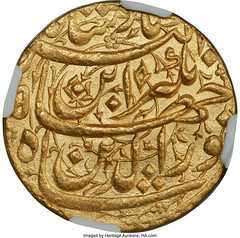
India: Mughal Empire. Jahangir (AH 1014-1037 / AD 1605-1627) gold Heavy (Sawai) Mohur AH 1019 Year 5 (1609) MS62 NGC
Among my favorite types we are beginning to handle with greater regularity are Mughal Mohurs, especially those of Jahangir. While the calligraphy on these expansive gold types is always appreciable, the floral or foliate elements to both faces sets these apart from other contemporary gold types. When witnessed at near-choice mint state, the fields glisten, highlighting those features further, and becoming a work of art.
To read the complete item description, see:
India: Mughal Empire. Jahangir (AH 1014-1037 / AD 1605-1627) gold Heavy (Sawai) Mohur AH 1019 Year 5 (1609) MS62 NGC
(https://coins.ha.com/itm/india/mughal-empire/india-mughal-empire-jahangir-ah-1014-1037-ad-1605-1627-gold-heavy-sawai-mohur-ah-1019-year-5-1609-ms62-ngc-/a/3118-33203.s)
MAKAR'S PICKS
Makar Polishchuk | Intern, World & Ancient Coins
This attractively styled prize coin celebrates the fifth anniversary of the restoration of the monarchy in 1940. With a mintage of only 140 and even fewer certified examples, it stands out for collectors and remains a key piece in the Greek series, appearing at auction perhaps only once or twice annually on average.
Its vibrant history includes significant world events and the life of George II. He acceded to the Greek throne but was exiled to Romania in October 1923 after a failed royalist coup. He resumed his royal duties in 1935 following a rigged referendum. His reign spanned from September 1922 until March 1924, and again from November 25, 1935 until his death in April 1947.
The unique history of his return to power and his rule through World War II makes this coin a collectible masterpiece. It is one of, if not the, most recognizable and contested issues of Greek numismatics from the 20th century.
To read the complete item description, see:
Greece: George II gold Proof "Restoration" 100 Drachmai 1935-Dated (1940) PR66 Ultra Cameo NGC
(https://coins.ha.com/itm/greece/greece-george-ii-gold-proof-restoration-100-drachmai-1935-dated-1940-pr66-ultra-cameo-ngc-/a/3118-33202.s)
This coin is always found in beautiful color and stunning design. It is one of the most desirable pieces of "modern" Japanese coins, marking the first year of production for a new monetary system based on the Yen and utilizing presses from the Hong Kong mint.
The Meiji era (1868-1912) was the first half of the Empire of Japan, during which the entire country transitioned to a modern, industrialized nation-state, adopting Western scientific, technological, philosophical, political, legal, and aesthetic ideas. This period marked the transition from the Edo period to the Meiji era in politics and society.
Very rare and desired worldwide, the number of certified coins indicates its scarcity and popularity. It is one of the masterpieces that initiated Japan's new monetary system.
To read the complete item description, see:
Japan: Meiji gold 20 Yen Year 3 (1870) MS62 NGC
(https://coins.ha.com/itm/japan/japan-meiji-gold-20-yen-year-3-1870-ms62-ngc-/a/3118-33222.s)
ERIC'S PICKS
Eric Sundstrom | Numismatist, World & Ancient Coins
It is always a joyous numismatic occasion when conditions align perfectly and a conditional outlier of an already scarce issue creates a coin of titanic significance. This one-year type is the inaugural date for both the Leu denomination and silver coinage issued by Romania as an independent nation. It also contains a "C" privy mark on the reverse, which is not a mint mark, but an initial for Candescu, the chief engineer of the State Mint of Bucharest; an occurrence that would cease after 1870. As we can see, this coin has many admirable qualities that have contributed to its popularity as an integral piece of Romanian numismatic history. This present specimen is likely the finest example still in existence, easily besting an NGC MS66 for the title of "Top Pop" among those certified by the most trusted of American Third Party Grading companies. We would not be surprised to see a bidding war of epic proportions when this miraculous Superb Gem specimen crosses the auction block along with the rest of the Romanian treasures from the Carpathian Collection.
To read the complete item description, see:
Romania: Carol I Leu 1870-C MS67 PCGS
(https://coins.ha.com/itm/romania/romania-carol-i-leu-1870-c-ms67-pcgs-/a/3118-31039.s)
A visually captivating type that is of striking similarity to the Caesar coinage to which this issue clearly pays homage to. Though not the rarest of types, with auction appearances on a yearly basis being somewhat numerous worldwide, this splendid design provides a clear lineage from Roman coinage to Medieval Continental coinage and the slightly more advanced minting processes. This historical linkage resonates with collectors and increases the emission's desirability, appealing to enthusiasts of both Ancient and Medieval numismatic persuasion. This Choice Mint State example will provide a fortunate collector the opportunity to own an excellent representative of this storied type that would be one of the more unique looking coins in any collection.
To read the complete item description, see:
Italy: Sicily. Frederick II (1197-1250) gold 1/2 Augustalis ND (1231-1250) MS63 NGC
(https://coins.ha.com/itm/italy/sicily/italy-sicily-frederick-ii-1197-1250-gold-1-2-augustalis-nd-1231-1250-ms63-ngc-/a/3118-33212.s)
ZACH'S PICKS
Zach Beasley | Director of Ancient Coins


Ancients: SICILY. Syracuse. Deinomenid Tyranny, Hieron I (ca. 475-470 BC). AR tetradrachm (24mm, 17.45 gm, 7h). NGC Choice XF Star 5/5 - 5/5
Although I didn't handle many Greek coins when I was a dealer before coming to Heritage, I've seen many Syracusan types and denominations during my time here, and this early tetradrachm type has grown on me. There's something about holding a beefy ancient silver coin, and this particular one has so much going for it - excellent centering, beautiful style, and rainbow toning. It's exactly the kind of coin that draws your attention and makes you want to pick it up to admire all the details.
To read the complete item description, see:
Ancients: SICILY. Syracuse. Deinomenid Tyranny, Hieron I (ca. 475-470 BC). AR tetradrachm (24mm, 17.45 gm, 7h). NGC Choice XF Star 5/5 - 5/5
(https://coins.ha.com/itm/ancients/greek/ancients-sicily-syracuse-deinomenid-tyranny-hieron-i-ca-475-470-bc-ar-tetradrachm-24mm-1745-gm-7h-ngc-ch/a/3118-33004.s)
Wow, where do I even begin with this one? The portrait style and meticulous details are off the chart, especially compared to the companion aureus minted in Rome. This Spanish mint issue is gorgeous and quite rare, with only a small handful known. Then, there is the historical aspect of the coin, hailing from Vespasian's campaign against Judaea and the resulting Judaea Capta issues. I'm certain this will be one of the most active lots in the ancients part of the auction, and it will be a centerpiece for the fortunate high-bidder.
To read the complete item description, see:
Ancients: Vespasian (AD 69-79). AV aureus (19mm, 7.40 gm, 6h). NGC MS 5/5 - 2/5, brushed
(https://coins.ha.com/itm/ancients/roman-imperial/ancients-vespasian-ad-69-79-av-aureus-19mm-740-gm-6h-ngc-ms-5-5-2-5-brushed/a/3118-33058.s)


Ancients: Gordian III (AD 238-244). AE medallion (37mm, 47.83 gm, 11h). NGC Choice VF 4/5 - 3/5, Fine Style
One question I often get is, "How did you get started collecting ancient coins?" I was on holiday with my mom and sister in Italy in the 1990s when I went into a coin store in Rome and discovered ancient coins. I bought a Gordian III antoninianus, which I still have in my collection, and because of that start, Gordian III will always have a place in my heart. On that trip, of course, we visited a ton of ancient sites, including the Colosseum. If you haven't seen it yourself, you really should go. It's unbelievable to experience. The rare types depicting this architectural marvel are always sought after. Fun fact - sometimes, there are reenactors there in various Roman military regalia, and one challenged me to arm wrestling. Not fun fact - I lost. I still had a great time, though!
To read the complete item description, see:
Ancients: Gordian III (AD 238-244). AE medallion (37mm, 47.83 gm, 11h). NGC Choice VF 4/5 - 3/5, Fine Style
(https://coins.ha.com/itm/ancients/roman-imperial/ancients-gordian-iii-ad-238-244-ae-medallion-37mm-4783-gm-11h-ngc-choice-vf-4-5-3-5-fine-style/a/3118-33078.s)
MADISEN'S PICKS
Madisen Caster | Specialist, Ancient Coins


Ancients: MACEDON. Chalcidian League. Ca. 432-348 BC. AR tetradrachm (27mm, 14.46 gm, 1h). NGC AU Star 4/5 - 4/5, Fine Style, light marks
This session has some stunning coins, but something about this stater's restrained, ethereal beauty stands out to me. The artistry is exceptional, and the subtle silhouette toning highlights the idealistic portrait of Apollo. Receiving both the Star and Fine Style designations, this is definitely a coin that should be appreciated in hand.
To read the complete item description, see:
Ancients: MACEDON. Chalcidian League. Ca. 432-348 BC. AR tetradrachm (27mm, 14.46 gm, 1h). NGC AU Star 4/5 - 4/5, Fine Style, light marks
(https://coins.ha.com/itm/ancients/greek/ancients-macedon-chalcidian-league-ca-432-348-bc-ar-tetradrachm-27mm-1446-gm-1h-ngc-auand-9733-4-5-4-5-f/a/3118-33010.s)


Ancients: Nero, as Augustus (AD 54-68). AE sestertius (36mm, 31.60 gm, 5h). NGC Choice AU 4/5 - 2/5, Fine Style
A sharp turn from the simplicity of the tetradrachm, this Port of Ostia Sestertius features detailed and complex design choices. The Fine Style devices are remarkable; it's incredible how much the engraver included on such a small canvas. Commemorative architectural types are always popular with collectors, and I expect this one will be a favorite of the session.
To read the complete item description, see:
Ancients: Nero, as Augustus (AD 54-68). AE sestertius (36mm, 31.60 gm, 5h). NGC Choice AU 4/5 - 2/5, Fine Style
(https://coins.ha.com/itm/ancients/roman-imperial/ancients-nero-as-augustus-ad-54-68-ae-sestertius-36mm-3160-gm-5h-ngc-choice-au-4-5-2-5-fine-style/a/3118-33053.s)


Ancients: Faustina Junior (AD 147-175/6). AV aureus (20mm, 7.19 gm, 5h). NGC AU 5/5 - 4/5, Fine Style
Completing my picks with another simplistic type, I really enjoy the softness of this aureus; the portrait is youthful, the surfaces are satiny, and even Venus' drapery seems to pool around her in a pleasing way. It strikes a delightful balance between intricacy and restraint, resulting in a coin that overall feels quite feminine and elegant.
To read the complete item description, see:
Ancients: Faustina Junior (AD 147-175/6). AV aureus (20mm, 7.19 gm, 5h). NGC AU 5/5 - 4/5, Fine Style
(https://coins.ha.com/itm/ancients/roman-imperial/ancients-faustina-junior-ad-147-175-6-av-aureus-20mm-719-gm-5h-ngc-au-5-5-4-5-fine-style/a/3118-33068.s)
STACKS BOWERS PHYSICAL BITCOIN AUCTION
Physical Cryptocurrency continues to be popular at auction. Here's a press release about offerings in the Stack's Bowers August 2024 Global Showcase Auction. -Editor
Stack's Bowers Galleries is excited to announce the Physical Bitcoin and Cryptocurrency session of their August 2024 Global Showcase Auction. Featured are more than 100 crypto lots that span from the classic Casascius, Lealana and BTCC series to more modern collector favorites by Polymerbit, Alpen Coin, Denarium,1HoDLCLUB, Satori, Rarity Check, Caribbean Treasures, and other creators. These lots boast a combined face value of over 40 BTC, currently equivalent to more than $2.7 million. The session is now posted on the Stack's Bowers Galleries website for pre-bidding; live bidding will begin on Monday, August 12 at 4PM PDT (7PM EDT). Winning bidders can also pay with Bitcoin via BitPay.
This sale is highlighted by an incredible 2011 Casascius 25 Bitcoin, which represents the live auction debut for the type. It was acquired directly from Mike Caldwell, the creator of the Casascius series, and has been cherished in a private collection ever since. It is one of only three graded by PCGS and carries a current face value of approximately $1.7 million.
This 25 Bitcoin is accompanied by many other treasures from the historic Casascius series. Among these is a 2013 1 Bitcoin in silver, which is the exact variety that was presented to Donald Trump by David Bailey, CEO of Bitcoin Magazine, at the recent Bitcoin 2024 Conference in Nashville. Also included is a rare "Gold Rim" 1 Bitcoin in silver, as well as a comprehensive set of brass 0.5 and 1 Bitcoin pieces including the prized 2011 "Error" variety. Within the Non-Loaded category, this series is highlighted by a redeemed 2011 25 Bitcoin and an extremely rare unfunded 2011 "Storage" Bar.
The Stack's Bowers Galleries sale also presents an impressive offering of coins from the BTCC series created by famed bitcoin entrepreneur Bobby Lee. Featured is a complete 6-coin set of the 2016 Poker Chip types as well as a range of denominations from the V Series struck in Titanium including the 0.1 Bitcoin, 0.5 Bitcoin, and 1 Bitcoin. Also included in the Non-Loaded category is a redeemed 2016 BTCC 5 Bitcoin which represents the first auction appearance of the issue.


Lot 1077: Unfunded 2023 Lealana "Grim Reaper" 0.2020 Bitcoin. Error Variety. Rainbow Gilt Finish. 2oz 999 Fine Silver.
The Lealana series is represented by a wide range of types from the classic 2013 issues (such as rare 0.1 Bitcoin pieces in silver and an unfunded "Gold B" 1 Bitcoin) to modern favorites like the Grim Reaper and King Kam issues. This is also perhaps the firm's most exciting selection of crypto banknotes from the Polymerbit series, with 20 lots that include rare conference and meet-up notes as well as unique pre-production notes, test specimens, and uncut sheets.
With over 40 BTC presented across more than 100 crypto lots, the Stack's Bowers Galleries August 2024 crypto sale is poised to be a truly landmark event for this new collectible category. If you have any questions on the August sale or the category in general, contact Stack's Bowers Galleries at Consign@StacksBowers.com or 800.566.2580. The firm is now accepting crypto consignments to their November and January crypto sales.
To read the complete article, see:
August 2024 Global Showcase Auction - Session 1 - Physical Cryptocurrency - Lots 1001-1123
(https://auctions.stacksbowers.com/auctions/3-1BAXJT/august-2024-global-showcase-auction-session-1-physical-cryptocurrency-lots-1001-1123)
PERSIAN GOLD COINS FOUND IN TURKEY
University of Michigan archaeologists found a hoard of Persian gold coins in western Turkey. -Editor
A team of researchers led by a University of Michigan archaeologist has uncovered a hoard of gold coins, likely used to pay mercenary troops, buried in a small pot in the ancient Greek city of Notion in western Turkey.
The coins show a figure of a kneeling archer, the characteristic design of the Persian daric, a type of gold coin issued by the Persian Empire and probably minted at Sardis, 60 miles northeast of Notion, said U-M archaeologist Christopher Ratté, professor of classical studies, curator of the Kelsey Museum of Archaeology and director of the Notion Archaeological Project, the project that discovered the coins.
The hoard, which the U-M team dated to the fifth century B.C., will provide another datapoint that can tell historians about the Persian daric's timeline and history.
Darics were minted from the late sixth century B.C. until the conquest of the Persian empire by Alexander the Great in 330 B.C., and the design of the coins remained the same with only minor stylistic differences. Researchers have tried to arrange the coins in a chronological sequence by analyzing those stylistic differences. One of the important aspects of the newly discovered hoard is that it is independently dated by other artifacts associated with the hoard.
"This hoard will provide a firm date that can serve as an anchor to help fix the chronology of the (entire sequence of coins)," Ratté said.
According to Andrew Meadows of Oxford University, formerly curator of coins at the British Museum and the American Numismatic Society, the archaeological context for the hoard is likely "if it can be established accurately by other means, to allow us to fine-tune the chronology of the Achaemenid gold coinage. This is a spectacular find … of the highest importance."
To read the complete article, see:
U-M team finds ancient Persian gold coins in western Turkey
(https://record.umich.edu/articles/u-m-team-finds-ancient-persian-gold-coins-in-western-turkey/)
Pablo Hoffman passed along a New York Times article on the find. Thanks. -Editor
It is the late fifth century B.C. and a mercenary soldier kneels in his modest quarters, digging a hole in the earthen floor. He places a small jug, called an olpe, in the hole for safekeeping and covers it with dirt. In the olpe are his savings — scores of gold coins, known as darics, each one equal to a month's pay.
But something happens to the soldier — possibly something sinister — and he never retrieves his hoard, which remains undiscovered for the next 2,400 years.
That is one of several scenarios proposed by Christopher Ratté, an archaeologist at the University of Michigan, to account for the cache, which he and his research team recently unearthed from the ruins of Notion, an ancient city-state in modern-day Turkey. While digging beneath the courtyard of a house dating to the third century B.C., the excavators found the remains of an earlier dwelling. "The coins were buried in a corner of the older building," Dr. Ratté said. "We weren't actually looking for a pot of gold."
To read the complete article, see:
Archaeologists Find a 2,400-Year-Old ‘Pot of Gold' in Turkey
(https://www.nytimes.com/2024/08/02/science/archaeology-turkey-daric.html)
2024 PARIS OLYMPIC MEDALS
I'm usually more on the ball with stories of Olympic medals. Thanks to Paul Horner for passing along this article. -Editor
The three types of medals have different metals.
The makeup of the most highly-coveted of the three medal types – the gold – largely includes silver with 6 grams of gold plating, according to NPR. Meanwhile, the silver medal contains the precious metal it derives its name from, the outlet reported.
Copper, tin and zinc are reportedly the medals used for the Paris Olympics third-place bronze medals.
Olympics officials tapped LMVH's Chaumet to come up with the design for both the Paris Olympics and Paralympics medals.
The jewelry brand sought to honor France and the Olympic host city, Paris, with its design for one side of the medals. To do so, it used a hexagon, a "series of rays" meant to represent "radiance" and a piece of iron from the iconic Eiffel Tower, LVMH explained in February.
On the flipside of the Olympic medals, they give "tribute to the Ancient Olympic Games in Greece, as well as the modern Games" by including both the Eiffel Tower and the well-known Acropolis, LVMH also said.
Other luxury brands under LVMH's umbrella have forms of representation in the Paris Olympics as part of its broader partnership with the 2024 Olympics and Paralympics.
Louis Vuitton, for instance, crafted the trunks meant to hold these Olympics' medals.
Looking at the metals (mostly silver) used to make the gold medals, one of the top Olympic awards is worth an estimated $1,027 for the Paris Olympics, according to Oxford Economics.
A silver medal could carry a lower estimated value, at $535, the firm figured.
For the third-place Paris Olympic medal, its estimate was $4.60.
Those figures, Oxford Economics said, did not factor in the "priceless" piece of iron from the Eiffel Tower incorporated into the gold, silver and bronze medals.
Here's a gold medal closeup from The New York Times.
Looking at the intrinsic metal value is a fine starting point, but the aftermarket value of these famous and coveted medals depends far more on the prestige of the event and the fame or notoriety of the recipient. The datapoints can be quite sparse - most of these medals don't hit the collector market, particularly not in the lifetime of the recipient. -Editor
To read the complete articles, see:
Paris Olympic medals: what is their worth and which company created their design?
(https://www.foxbusiness.com/sports/paris-olympic-medals-what-worth-which-company-created-design)
Gold, Silver and … Iron? Paris Olympic Medals Will Have Piece of the Eiffel Tower
(https://www.nytimes.com/2024/02/08/world/europe/paris-olympics-medals-eiffel-tower.html)
LOOSE CHANGE: AUGUST 4, 2024
Here are some additional items in the media this week that may be of interest. -Editor
Artwork "secured with NFP.io's revolutionary technology" illustrates an 1804 silver dollar, as discussed in this Coin World article by Larry Jewett. Here's an excerpt - see the complete article online. -Editor
 The first-ever artwork secured with NFP.io's revolutionary technology featuring built-in self-authenticating anti-duplication features will be seen in the work of artist Laura Verschoore, who has chosen the iconic 1804 coin as her painting's subject.
The first-ever artwork secured with NFP.io's revolutionary technology featuring built-in self-authenticating anti-duplication features will be seen in the work of artist Laura Verschoore, who has chosen the iconic 1804 coin as her painting's subject.
The groundbreaking piece goes to auction during the American Numismatic Association's World's Fair of Money at the ANA banquet on August 9. Proceeds will benefit the Robert Lecce Advanced Adult Scholarship Program for 2025.
Secret security features. Hidden within the canvas of the painting are three-dimensional non-replicable markers, invisible to the naked eye, that can be checked for authenticity using a quick and easy verification method. Think of it like a super high-tech fingerprint for your art, but even easier to confirm!
To read the complete article, see:
Art of 1804 dollar offers security for collector
(https://www.coinworld.com/news/us-coins/art-of-1804-dollar-offers-security-for-collector)
Andrew Crellin of Sterling & Currency in Australia published a thoughtful article on the bane of the coin dealer's existence - calls from the public about worthless coins. Here's an excerpt - see the complete article online. -Editor
I had a client ask me earlier today "You must meet a lot of cranks in your business - how many people have the wrong idea about the rarity of the coins they have?"
When answering about the general population and coin values, I figured that 27 out of 30 people contacted us after seeing something online about a coin or note they have.
The reality is my estimated ratio was a little harsh - our CRM shows that of the 780 questions we've received via our website over the past year from people looking to sell something, "only" 77% of them were from people who were acting based on what is effectively misinformation - I know this because I track it as part of our records. 77% isn't 90%, but it is still a majority.
This number confirmed my hunch that most people only ever contact us because they've seen something on the internet. They're not sure if what they've seen is true, so they decide to get the lowdown from someone who knows what they're talking about. They'll often ring us, contact us via our website or visit our office because they "know" their coin is rare and valuable.
To read the complete article, see:
Specialized Knowledge Beats General Knowledge Every Time
(https://www.sterlingcurrency.com.au/blog/news-research/the-humanity-of-it-all/specialized-knowledge-beats-general-knowledge-ever/)
For bibliophiles, this New York Times article reviews a new book on the history of the American bookstore. -Editor
 Probably by intention, Friss's book is organized like the best of such literary emporiums: a little higgledy-piggledy, with surprise diversions here and there. He approvingly considers the Instagram wall at Books Are Magic, the novelist Emma Straub's shop in the Cobble Hill neighborhood of Brooklyn, and less so the eponymous bibliosmia fragrance bottled by Powell's, the Portland, Ore., landmark.
Probably by intention, Friss's book is organized like the best of such literary emporiums: a little higgledy-piggledy, with surprise diversions here and there. He approvingly considers the Instagram wall at Books Are Magic, the novelist Emma Straub's shop in the Cobble Hill neighborhood of Brooklyn, and less so the eponymous bibliosmia fragrance bottled by Powell's, the Portland, Ore., landmark.
There are short sections on attractions like WonTon, the tuxedo cat who presided over a store in Richmond, Va., that was featured in Gary Shteyngart's novel "Lake Success." Cats in bookstores could be, in these days of their sudden political surge, a whole other book; "The Bookshop" is necessarily selective, and I looked without success for Bartleby, Mr. Eliot and Skimbleshanks, the lazy employees of E. Shaver in Savannah, Ga.
Disappointment at not finding your own fave in his copious index, Friss writes, speaks to how important these institutions are: "That so many people feel differently about their bookstore than they do about their grocery store or electronics store or any other store is part of the point."
One of the many functions of a bookstore Amazon cannot fulfill, since the closure of its brick-and-mortar stores, is hosting a function. Friss tells the story behind the famous group photograph of mostly poets during a party at the much-missed Gotham Book Mart, with Gore Vidal jostling in and William Carlos Williams excluded. (W.H. Auden, climbing to the top, "was one of the few who seemed to be enjoying himself.")
To read the complete article, see:
Browsing Is a Pleasure in This History of the Bookstore
(https://www.nytimes.com/2024/08/04/books/review/the-bookshop-evan-friss.html)









